Inpression Editing
Copy & Content That Makes Your Brand Soar

“Before” vs. “prior to”: What’s the difference?
If you’re someone who writes or creates content, there’s a dilemma you’ve probably faced: whether to use “before” vs. “prior to” in a particular sentence. For example, which one could you use here: “We considered all the evidence _____ making a decision”? Would you choose “before” or would you place your bets on “prior to”? You may be confident that you know which one fits. But do you really know the right answer?
“Before” vs. “prior to”: Which word could you use?
We’ve got good news for you: no matter which word you chose, you’re right. You can use either “before” or “prior to” in the sentence:
- “We considered all the evidence before making a decision.”
- “We considered all the evidence prior to making a decision.”
Why can you use either word? Because “before” vs. “prior to” mean the same thing. In fact, if you look up both words in major dictionaries (e.g., the Merriam-Webster Dictionary , Oxford Dictionaries , and the Collins Dictionary ), you’ll find that the definition of “prior to” is “before.” That’s why you could use either “before” or “prior to” in all these sentences:
- “Before attending law school, Janessa worked as a teacher.”
- “Prior to attending law school, Janessa worked as a teacher.”
- “They needed to finish the layout for the magazine before leaving for the day.”
- “They needed to finish the layout for the magazine prior to leaving for the day.”
- “You must let the chocolate cool before moving on to the next step.”
- “You must let the chocolate cool prior to moving on to the next step.”
“Before” vs. “prior to”: Which word should you use?
Now, just because you can use either “before” or “prior to” in any sentence doesn’t mean you should. It’s true that “before” vs. “prior to” are both grammatically correct choices for a sentence. But that doesn’t mean that they’re equally good choices.
If you read our posts on a regular basis, you’ll know that we like to keep things simple . That is, we always suggest using the simplest words that you can use in a sentence. Simple words make sentences easier to read and understand, and your number one job as a writer is to make your reader’s job as easy as possible. That’s why we believe “before” is always a better choice than “prior to.”
We know what some of you are thinking: “‘prior to’ is a better fit for a project proposal or report because it sounds more formal.” After all, you’re probably used to seeing corporate and legal documents that are peppered with this term. In reality, though, “prior to” is just a Latin-based synonym of “before” that sounds unnecessarily formal. In fact, the Merriam-Webster dictionary notes that some people even see “prior to” as pompous. And you don’t want to seem pompous, do you?
Remember that smart people are impressed by how clearly and simply you can explain something, not by how complex your writing is. That’s why we suggest resisting the temptation to use “prior to” and going with “before” no matter what. After all, there’s really no situation where you would need to use “prior to” instead of “before.”
“Before” vs. “prior to” may feel like different words that are appropriate for different types of sentences. But the reality is that they mean the same thing. That’s why no matter what you’re trying to say, you can simplify and strengthen your writing by using “before” instead of “prior to.”
—————————————————————————————————————————————
Want more tips on how to produce clear and concise content? Read our post on how to shorten long words and sentences .
————————————————————————————————————————————— Inpression Editing helps businesses, professionals, and students make the best impression possible on customers, investors, hiring managers, and admissions committees. We do this by providing copywriting, editing, and writing coaching services for website copy, blog posts, marketing materials, personal statements, and much more.
Located in Toronto, Canada, we provide all of our services in both Canadian and US English. Get an instant quote here .
- ← 5 blog post headline mistakes you need to stop making
- 9 blog title generator tools to help you craft the perfect headline + 72 title templates →
Leave a Reply Cancel reply
Your email address will not be published. Required fields are marked *
- More from M-W
- To save this word, you'll need to log in. Log In
preposition
Definition of prior to.
Sometimes termed pompous or affected, prior to is a synonym of before that most often appears in rather formal contexts, such as the annual reports of corporations. It may occasionally emphasize the notion of anticipation.
- afore [ chiefly dialect ]
- fore [ chiefly dialect ]
- 'fore
- previous to
Examples of prior to in a Sentence
These examples are programmatically compiled from various online sources to illustrate current usage of the word 'prior to.' Any opinions expressed in the examples do not represent those of Merriam-Webster or its editors. Send us feedback about these examples.
Word History
1706, in the meaning defined above
Dictionary Entries Near prior to
Cite this entry.
“Prior to.” Merriam-Webster.com Dictionary , Merriam-Webster, https://www.merriam-webster.com/dictionary/prior%20to. Accessed 9 Apr. 2024.
Kids Definition
Kids definition of prior to, more from merriam-webster on prior to.
Nglish: Translation of prior to for Spanish Speakers
Subscribe to America's largest dictionary and get thousands more definitions and advanced search—ad free!

Can you solve 4 words at once?
Word of the day.
See Definitions and Examples »
Get Word of the Day daily email!
Popular in Grammar & Usage
The tangled history of 'it's' and 'its', more commonly misspelled words, why does english have so many silent letters, your vs. you're: how to use them correctly, every letter is silent, sometimes: a-z list of examples, popular in wordplay, the words of the week - apr. 5, 12 bird names that sound like compliments, 10 scrabble words without any vowels, 12 more bird names that sound like insults (and sometimes are), 8 uncommon words related to love, games & quizzes.

- Cambridge Dictionary +Plus
Meaning of prior to something in English
Prior to something.
- before Try to arrive before the start of the meeting.
- prior to All utensils should be washed prior to use.
- in advance of Call in advance of your visit to see if you'll need a parking reservation.
- ahead of My sister is arriving ahead of me to do the grocery shopping for the weekend.
- by Make sure you're back by midnight.
Translations of prior to something
Get a quick, free translation!

Word of the Day
Your browser doesn't support HTML5 audio
a group of four people who play musical instruments or sing as a group

Shoots, blooms and blossom: talking about plants

Learn more with +Plus
- Recent and Recommended {{#preferredDictionaries}} {{name}} {{/preferredDictionaries}}
- Definitions Clear explanations of natural written and spoken English English Learner’s Dictionary Essential British English Essential American English
- Grammar and thesaurus Usage explanations of natural written and spoken English Grammar Thesaurus
- Pronunciation British and American pronunciations with audio English Pronunciation
- English–Chinese (Simplified) Chinese (Simplified)–English
- English–Chinese (Traditional) Chinese (Traditional)–English
- English–Dutch Dutch–English
- English–French French–English
- English–German German–English
- English–Indonesian Indonesian–English
- English–Italian Italian–English
- English–Japanese Japanese–English
- English–Norwegian Norwegian–English
- English–Polish Polish–English
- English–Portuguese Portuguese–English
- English–Spanish Spanish–English
- English–Swedish Swedish–English
- Dictionary +Plus Word Lists
- English Phrase
- Translations
- All translations
Add prior to something to one of your lists below, or create a new one.
{{message}}
Something went wrong.
There was a problem sending your report.
An official website of the United States government
The .gov means it’s official. Federal government websites often end in .gov or .mil. Before sharing sensitive information, make sure you’re on a federal government site.
The site is secure. The https:// ensures that you are connecting to the official website and that any information you provide is encrypted and transmitted securely.
- Publications
- Account settings
Preview improvements coming to the PMC website in October 2024. Learn More or Try it out now .
- Advanced Search
- Journal List
- Front Med (Lausanne)
Preparing for Telemedicine Visits: Guidelines and Setup
Aman prasad.
1 Perelman School of Medicine, University of Pennsylvania, Philadelphia, PA, United States
Ryan Brewster
2 Stanford University School of Medicine, Stanford University, Stanford, CA, United States
Divya Rajasekaran
3 Department of Endocrinology, Summit Medical Group, Berkeley Heights, NJ, United States
Karthik Rajasekaran
4 Department of Otorhinolaryngology – Head and Neck Surgery, Perelman School of Medicine, University of Pennsylvania, Philadelphia, PA, United States
Introduction
In response to the 2019 coronavirus disease (COVID-19), many medical practices have canceled outpatient visits in an effort to protect healthcare workers and the public. As an efficient way to maintain chronic care for patients, physicians have turned to telemedicine visits for outpatient appointments as a way to maximize their social distancing ( 1 – 3 ). Physicians can use a variety of telecommunication services, such as Zoom (San Jose, CA), Doximity (San Francisco, CA), etc., to virtually meet with patients and perform basic assessments for future follow-up. Telemedicine has become a mainstay of patient care in the medical climate of the COVID-19 pandemic. Given its many benefits, such as convenience, time efficiency, cost savings, and ease of use, telehealth services may continue to grow in popularity for some time ( 4 , 5 ). It is worth noting, however, that there are apparent limitations to the use of remote visits, namely the inability to conduct a comprehensive physical exam and to perceive non-verbal communication. We do not assert that telemedicine represents a new paradigm of all future patient care. However, given the recent resurgence of COVID-19 cases in many states, telehealth services may play a major role in healthcare for longer than initially expected.
With rapid implementation of telemedicine, there has been very little time for physicians and patients to fully adjust to this new medium of patient care. In order to maximize the efficiency, utility and value of these telemedicine visits, it is crucial for both parties to be properly educated and prepared. Previous studies have shown high patient satisfaction with ambulatory telemedicine visits, however patients frequently noted overall setup, technological barriers, and appointment expectations as points for future improvement ( 6 – 9 ). Thus, quality improvement initiatives aimed at increasing patient and physician preparedness for virtual medical appointments will play a large role in maximizing patient satisfaction for such visits, which has been shown to impact the overall success and adoption of telemedicine programs ( 10 ). Our group has previously designed and distributed a set of guidelines and a patient-facing handout in order to facilitate more effective, time efficient telemedicine visits for otolaryngology patients ( 11 ). In the authors' experience, use of this handout has vastly improved patient preparedness for such appointments. Its use has since been expanded to the entire department and patient satisfaction with telemedicine visits has also vastly improved ( 6 , 12 ). To our knowledge, such a handout or graphic has not been developed or distributed in other medical fields. In this paper, we aim to provide the medical community with a useful patient handout on telemedicine preparedness that can be applied to a variety of specialties. In addition, we further outline and elaborate on such expectations on the side of both healthcare providers and patients.
Guidelines for Healthcare Providers
Firstly, physicians should ensure their technological setup is secure and professional prior to any appointment. This includes maintaining a robust internet connection, having clear video, and smooth audio. While verbal aspects of obtaining patient history is largely unimpaired through a telemedicine visit, aspects of the physical exam are much more difficult to accomplish. If the physician asks a patient to perform aspects of a physical exam, the physician should first attempt to demonstrate such maneuvers on themselves first. This will mitigate any lapses in communication between physicians and patients during such tasks. Additionally, physicians' administrative staff should contact the patient at least a day in advance of their appointment in order to provide them with adequate setup information. This could include distributing a clear, concise handout such as the one provided in Figure 1 . Such communication provides patients ample opportunity to gather materials and become familiarized with specific expectations for the visit. Lastly, physicians may find it appropriate to add other consult services, such as social workers or nurse navigators, to the video call for patients dealing with complex issues. In this way, telemedicine visits can act as a multidisciplinary tool for patients to interact with providers in a single, unified setting.

Telemedicine handout.
Guidelines for Patients
Positioning.
Similar to guidelines published previously ( 11 ), we advise patients to sit on a stable chair with good posture. Patients should also sit in a room with proper lighting, avoiding light sources positioned behind their backs as this can lead to a silhouette effect. These preparations will ensure that physicians have a clear view of patients throughout the visit, which can be difficult to maintain in cramped or dim conditions. The patients' video camera should also be placed as close to eye-level as possible. If patients utilize phones or iPads for their visit, they may be instructed to support these devices on books or other materials around the house in order to keep both hands free for possible physical exam tasks physicians may request patients to perform (see Figure 1 ).
Patients should be notified of any specific equipment they may need prior to the telemedicine visit. A laptop, phone, or tablet would be necessary for conduction of the telemedicine visit itself. Patients should ensure these devices work properly prior to the visit as well. This can be accomplished by video-chatting a family member or friend to ensure the microphone and camera are functioning properly. If accessible, having a blood pressure cuff, glucometer, or weighing scale may be helpful in order to record rudimentary vital signs. Lastly, patients should be prepared with an updated and comprehensive list of active medications to aid the physician during the history taking process (see Figure 1 ).
Additional Considerations
If requested by the physician, patients should be prepared with recent logs of blood pressure readings, blood glucose levels (from glucometer readings), and weight. If possible, patients should have a family member or friend present during the visit to assist with aspects of the physical exam or with camera positioning onto an area of interest. If patients have scheduled the visit to examine a certain body part of interest, they should take care to wear loose clothing that can allow that area to be easily visible if needed. A supplementary light source such as a flashlight can aid in such visualization over video as well. In this case, physicians can ask a family member or friend of the patient, if present, to assist in focusing the light source if the patient finds it difficult ( Figure 1 ).
Due to social distancing policies enacted as a result of COVID-19, the prevalence of virtual ambulatory visits has rapidly grown. Such visits may remain popular among healthcare providers with the recent resurgence of COVID-19 cases in the United States. Using the authors' experience and previous literature, we have provided a basic framework with which all medical practices can prepare for their telemedicine visits. In particular, we have designed a graphical guide for patients meant to be distributed by practices to improve patient awareness and increase appointment efficiency. By providing this structure, it formalizes the telemedicine protocols to more accurately represent an in-person physician appointment. Given the recent, widespread adoption of this practice, these guidelines can be used as a basis for telemedicine visits even beyond the COVID-19 pandemic.
Author Contributions
All authors provided substantial contributions to the conception of work, critical revisions for important intellectual content, final approval of version, and agreement to be accountable for all aspects of the work.
Conflict of Interest
The authors declare that the research was conducted in the absence of any commercial or financial relationships that could be construed as a potential conflict of interest.

How to use today’s visit to plan for the next one
Pre-visit planning is a way to ensure that your patients get the tests they need — and you get the test results you need — before their next visit. Then you can devote more attention during the visit to interpreting, discussing, and responding to that information.
The process begins at the end of the current visit:
• Identify what labs or other tests the patient should complete before the next visit. Using a “ post-appointment order sheet ” can be helpful, as it allows you to simply check the boxes for any tests the patient needs either the same day, before the next visit, before the annual wellness visit, or before a scheduled procedure.
• Have your staff enter the order and then work with the patient to schedule the tests and the follow-up visit before leaving the office, which will improve compliance. Patients may need to obtain tests several days before the follow-up appointment. However, if your practice uses point-of-care testing or has standard lab testing with a quick turnaround, patients may be able to have their blood drawn 15 minutes to an hour before their follow-up appointment.
Once the patient has completed the pre-visit lab testing, the following steps should occur:
• On the day of the follow-up visit (or the day before), the medical assistant or nurse can help organize the visit for the physician by making sure the results are available and doing a quick review of the patient's record to see what other needs the patient may have during the appointment (an immunization, screening, etc.).
• Conduct a brief “mini-huddle” before the visit. The nurse or medical assistant often learns important medical and social information during patient rooming. A brief “mini-huddle” before the physician meets with the patient can be helpful, ensuring a more efficient, organized visit.
Read the full FPM article: “ Putting Pre-Visit Planning Into Practice .”
Get "Quick Tips" in your inbox
Sign up to receive FPM 's free, weekly e-newsletter, "Quick Tips & Insights," featuring practical, peer-reviewed advice for improving practice, enhancing the patient experience, and developing a rewarding career.
- Career management
- Patient care
- Practice management
- RSS ( About RSS )
Other Blogs
- Getting Paid from FPM journal
- AFP Community Blog
- FPs on the Front Lines
- Fresh Perspectives
- In the Trenches
- Leader Voices
Disclaimer: The opinions and views expressed here are those of the authors and do not necessarily represent or reflect the opinions and views of the American Academy of Family Physicians. This blog is not intended to provide medical, financial, or legal advice. All comments are moderated and will be removed if they violate our Terms of Use .
Copyright © 2024 American Academy of Family Physicians. All Rights Reserved.
How to Craft a Perfect Pre-Meeting Email Template
Updated: July 01, 2022
Published: May 02, 2022
As salespeople and professionals, I'm sure you can relate to the sheer number of cold emails I get every hour of every day of the week. With so much noise in our inboxes (not to mention the issue of limited time), there’s a good chance we're not opening all of those emails.

But when I receive a pre-meeting email from a salesperson I’m about to meet, the odds are much better that I’ll open the email and review the content.

In this article we'll discuss:
- The importance of sending a pre-meeting email
- How to write a pre-meeting email
- Pre-meeting email examples and templates
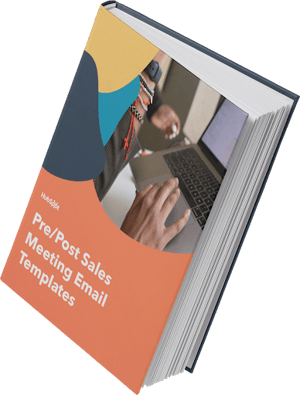
Download Now
What is a pre-meeting email?
A pre-meeting email is an email sent prior to the meeting to help the recipient or prospect prepare ahead of time. Essentially this correspondence sets the tone for what the prospect can expect during the meeting and ensures everyone is on the same page.
While I am more likely to view this person’s email due to our upcoming commitment and prior relationship, I expect more from the email in terms of content.
.png)
5 Free Pre-Sales Meeting Email Templates
Equip your sales team with these voicemail scripts for any occasion.
- Communicate with prospects.
- Iron out your messaging.
- Save time writing.
- Customize to your brand.
You're all set!
Click this link to access this resource at any time.
The Importance of a Pre-Meeting Email
One simple advantage of sending a pre-meeting email is standing out from the competition. You will stay in front of prospects and differentiate yourself if you do some research and get personal.
You also need to keep track of your promises and recommendations throughout the sales process, so that follow-through is carried out with precision, and a pre-meeting email can help you achieve this end. Making business personal and meeting (or better yet, exceeding) expectations are two ways to close more deals.
How to Write an Email for a Meeting
Creating a pre-meeting email template.
You might know that you need to write a pre-meeting email, and you might even know some of the basics of pre-meeting email content, but actually crafting such an important piece of communication doesn’t always come easily.
At the very least, your pre-meeting email should include a reminder confirming the location, time, and date of the meeting. You also should ensure attendees know the purpose of the meeting, along with any reports, pre-reading, or requests for materials a day or two in advance.
Tell us a little about yourself below to gain access.
To create a solid pre-meeting email template, we suggest you follow these steps:
1. Include a specific subject line.
For simplicity, the subject line should include the meeting day and topic. The more attention-grabbing or relevant the subject line is, the more likely your prospect is to open it.
According to Invesp , 47% of email recipients open them based on the subject line. Emails with a personalized subject line were 22% more likely to be opened over those without one.
2. Write a personal greeting.
A simple greeting such as "Hi [name]!" or Hello [name] will suffice.
3. Write a brief reminder paragraph.
This paragraph should cover the purpose of the meeting and what you expect.
For example:
"I’m looking forward to meeting you at [location and time]. As I mentioned during our phone call on [date], I’ll be sharing [product], which relates to your [goal]. We aim to [witty line about your company brand]."
4. Write a brief closing paragraph.
Your closing paragraph can help guide the prospect to a piece of company content. This could be a link to a video, white paper, or some other quality content relating to your meeting.
Offer to provide any other materials that the prospect wants, and make yourself available for questions or feedback.
"You can see a short video about [product] on our website if you’re curious. Feel free to email or call if you have any questions or further needs before we meet on [date and time]."
5. Wrap it up.
Personalizing a pre-meeting email.
Keep in mind that the pre-meeting email template can only get you so far. If you haven’t truly adopted your company’s CRM yet, you need to do so to craft a killer personalized pre-meeting email.
All of the personal information you need about your prospects is in that CRM, and your job as a sales representative becomes much easier when you rely on your company’s existing tools and data when communicating with prospects.
Additionally, remember to include the sales content that matters most to your prospect in your pre-meeting email. If you’re not sure where to find the right content, utilize your company’s sales and marketing productivity tools . Personalizing your pre-meeting email with just the right content could make or break your deal.
Pre-Meeting Email Template
We've covered quite a bit here. Let's get the ball rolling using the HubSpot email template below as a starting point.
1. Standard Pre-Meeting Email Template

Hope you had a nice few days out of the office!
I'm looking forward to our meeting tomorrow. I'd like to walk away having a better understanding of your pain points with global logistics, your team's 2022 goals, and how our international logistics software can help you achieve them.
In the meantime, we just released a new case study with a company I think yours has quite a lot in common with. Here's the link: [Insert link].
Let me know if you have any questions. Otherwise, looking forward to connecting tomorrow at 11:00 AM ET. Hope you're surviving the post-vacation sluggishness!
Regards, Meg

What we like:
This example kept things short, concise, and direct. They've reminded the prospect of the meeting they both agreed to, provided them with a brief outline of what will be discussed, and provided value to them in the form of a relevant content offer.
2. Friendly Reminder Pre-Meeting Email Template
Sometimes you may just want to send a quick follow-up to confirm your meeting. In this instance, you can use the template below.
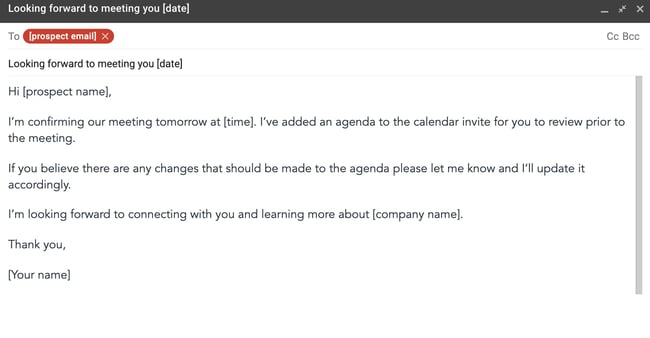
Hi Candice,
I’m confirming our meeting tomorrow at 2:30 PM. I’ve added an agenda to the calendar invite for you to review prior to the meeting.
If you believe there are any changes that should be made to the agenda please let me know and I’ll update it accordingly.
I’m looking forward to connecting with you and learning more about TriStar.
This email is short and sweet, confirming the date and time of the meeting, while also giving the recipient room to change the meeting date if the one listed is no longer feasible.
The addition of the agenda ensures that everyone comes to the meeting prepared and ready to discuss ideas.
3. Preparing a Prospect
Sometimes you may want to give your prospect materials to review prior to meeting to give them the opportunity to brainstorm and come up with questions. In this case, the email template below will be of good use.
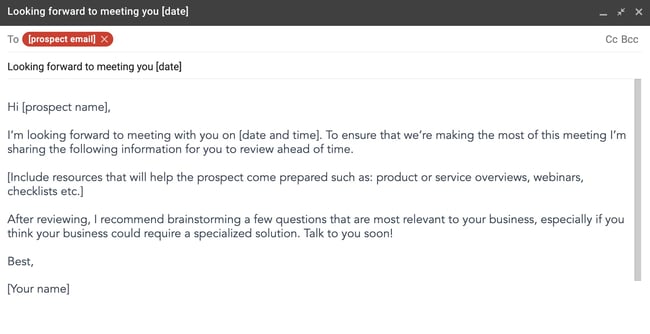
I’m looking forward to meeting with you this Thursday (4/8) at 10 AM. To ensure that we’re making the most of this meeting I’m sharing the following information for you to review ahead of time.
- Product and Service Overview
- Product Demo
After reviewing, I recommend brainstorming a few questions that are most relevant to your business, especially if you think your business could require a specialized solution. Talk to you soon!
This email gives the prospect everything they need to know prior to the meeting to ensure they're making the best use of their time. By giving the prospect materials like a demo or service overview ahead of time, they can digest the information on their own time and start to visualize how your product can provide value to their business. It also gives them time to prepare any questions they have ahead of time.
4. Confirming Attendees
While you may have only one contact at the prospect's company, others may want to attend the meeting. Use the template below to make sure all attendees get the invite.
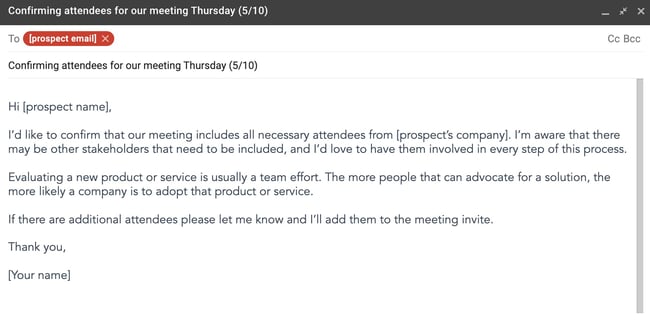
Hello Robert,
I’d like to confirm that our meeting includes all necessary attendees from ClearPoint. I’m aware that there may be other stakeholders that need to be included, and I’d love to have them involved in every step of this process.
Evaluating a new product or service is usually a team effort. The more people that can advocate for a solution, the more likely a company is to adopt that product or service.
If there are more guests you'd like to attend, please let me know and I’ll add them to the meeting invite.
This example displays the sales rep's understanding of the importance of having all stakeholders involved in the decision-making process.
Giving prospects the opportunity to add more guests will get more stakeholders involved and give you access to other contacts within the company.
Pre-Meeting Emails are Worth the Extra Step
Sending a pre-meeting email might seem formal, but it's a great way to ensure your plans go smoothly. Additionally sending an email ahead of time adds a human touch to your meeting instead of it being a faceless hold on your prospect's calendar.
Communication and relationship-building are what selling is all about, but you can't do either if you never meet.
Editor's note: This post was originally published on August 1, 2015 and has been updated for comprehensiveness.

Don't forget to share this post!
Related articles.

How to Reschedule a Meeting Professionally in 2024
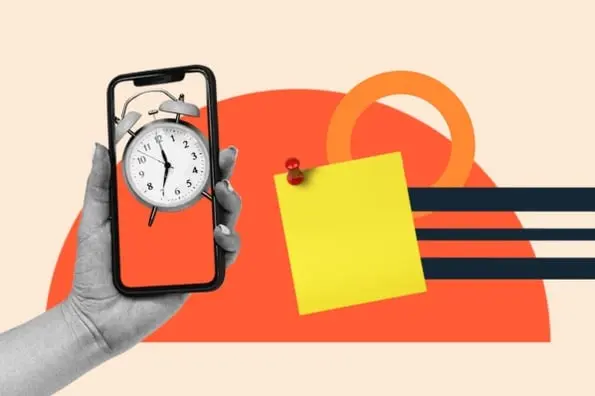
The Best 24 Appointment Scheduling Apps and Booking Software
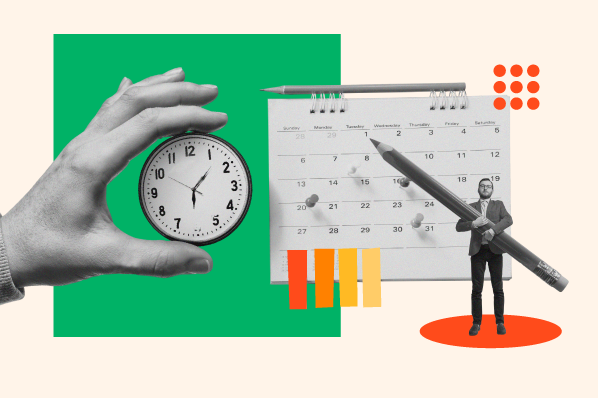
How to Get an Appointment With Anyone in 3 Simple Steps
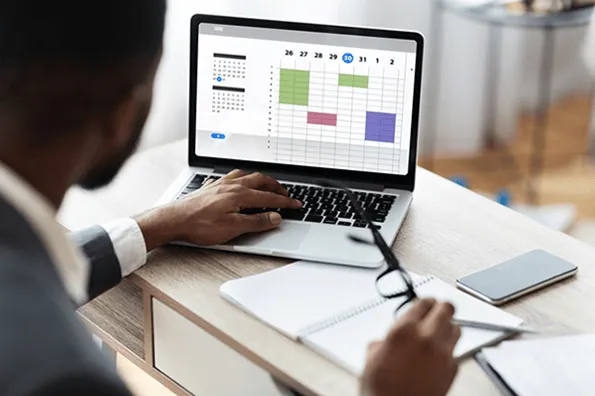
How to Find a Meeting Time That Works for Everyone (Plus Tools)

15 Best Event Scheduling Polls & Meeting Survey Tools for Your Team

The Sales Huddle: 9 Ideas to Drive Your Next Team Meeting

Why B2B Appointment Setting Should Be Part Of Your Sales Strategy

Sales Meeting Agenda: The Master Tip for Closing More Deals

Face-to-Face Meetings: The Ultimate Guide

The Best Days and Times for Sales Meetings, According to New Data
Use these templates to easily and quickly craft emails to send before and after sales meetings.
Powerful and easy-to-use sales software that drives productivity, enables customer connection, and supports growing sales orgs

- Auditing Services
- Coding Services
- Consulting Services
- Provider Education
- Medical Auditing Boot Camp (CPMA Prep)
- E&M Auditing Boot Camp (CEMA Certification)
- Medical Auditing Interactive Workshop
- E&M Resource Center
- Weekly Documentation & Compliance Tips
- Membership Benefits
- NAMAS Lite Membership
- Corporate Membership
- Refer-A-Friend
- Members Only
- NAMAS History
- Content Contributors
Pre-Op Visits vs. Pre-Op Clearance Visits: Which are Billable?
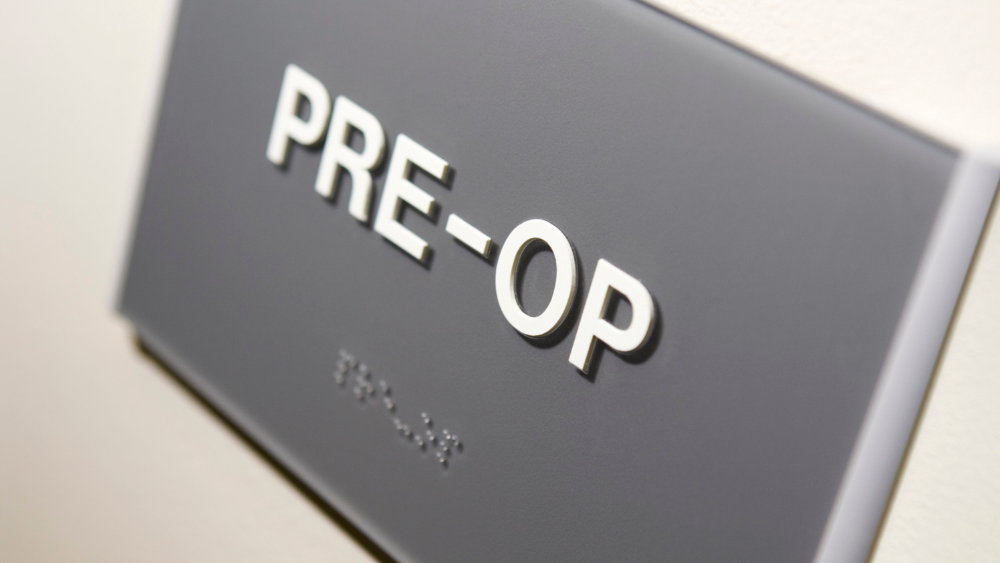
August 11, 2023 | By Terry A. Fletcher BS, CPC, CCC, CEMC, CCS, CCS-P, CMC, CMSCS, ACS-CA, SCP-CA, QMGC, QMCRC, QMPM | Terry Fletcher Consulting, Inc. | Healthcare Coding and Reimbursement Consultant, Educator and Auditor | Podcast Host, CodeCast®, NSCHBC Edge Podcast, #TerryTuesday TCG Podcast | NAMAS Educational Speaker and Writer
A question comes up often regarding billing for pre-op visits. Should we? Or shouldn’t we? There is conflicting published guidance on this question from different sources.
First, this depends on what you mean by “pre-operative visits”. Are you talking about a visit performed by the surgeon (or the surgeon’s QHP) or a provider not involved with the surgery? If the decision is made to perform the surgery during this encounter — whether initial or follow-up — then it is appropriate to report an E&M visit. If the surgery occurs on the same day or the following day, append modifier -57 to the E&M as the decision for surgery modifier.
However, if the patient is coming in for a “history and physical” or “pre-op” visit to obtain consents and answer questions the patient may have, this encounter is not billable as it is included in the reimbursement for the surgery. In the RVUs for all surgeries with a 90-day global period, there is pre and post-op work included for this encounter. It would be considered “double-dipping” and being paid twice. Many have the opinion that, technically, if this encounter happens two or more days before the surgery, you could bill it, but ethically you probably should not. I would disagree.
There is no CPT code for a non-billable H&P encounter. Some providers choose to use 99024 to track the frequency and the associated ICD-10-CM codes for these non-billable services. Others use a code they have created, such as pre-op, as a placeholder for these encounters when their EMR allows for it with no dollar figure attached. Other practices don’t track these encounters and may not enter them into the practice management system at all. Now, let’s look at a “pre-op clearance” or surgical clearance encounter that would not be done by the surgeon or the PA/NP practicing under the surgeon. A surgical pre-op clearance is where a specialist (i.e., Cardiologist or Internal Medicine physician) or PCP clears the patient for surgery. For instance, if a patient with CHF (congestive heart failure) is scheduled for a total right knee replacement under general anesthesia, the surgeon and anesthesiologist may request clearance from the patient’s cardiologist. The cardiologist is not performing the surgery and most likely follows the patient for this condition. Therefore, the cardiologist will not be paid for any services included in the global package. The cardiologist should code the pre-operative clearance encounter with the appropriate E&M code and follow the ICD-10-CM guidelines for the encounter.
These guidelines are in ICD-10-CM General Guidelines: Section IV, Item M “Patients receiving preoperative evaluations only. For patients receiving preoperative evaluations only, sequence first a code from subcategory Z01.81, Encounter for pre-procedural examinations, to describe the pre-op consultations. Assign a code for the condition to describe the reason for the surgery as an additional code. Code also any findings related to the pre-op evaluation.” In the hypothetical case mentioned above, the ICD10-CM codes would be Z01.810, M17.11, I50.9
Another scenario comes up that many coders and physicians attempt to code as a pre-op visit because of the hospital administrative mandate, but you have to determine what the visit is for. Example: Hospitals require that we do an H&P within 30 days of taking a patient to the OR. If this visit is more than 48 hours prior to surgery, is that a billable visit?
Answer: No, the H&P, in this case, is not a billable visit. This question comes up often and was addressed by AMA CPT® Assistant® in the following excerpt:
“If the decision for surgery occurs the day of or before the major procedure and includes the preoperative evaluation and management (E/M) services, then this visit is separately reportable. Modifier 57, Decision for Surgery, is appended to the E/M code to indicate this is the decision-making service, not the history and physical (H&P) alone. If the surgeon sees the patient and makes a decision for surgery and then the patient returns for a visit where the intent of the visit is the preoperative H&P, and this service occurs in the interval between the decision-making visit and the day of surgery, regardless of when the visit occurs (1 day, 3 days or 2 weeks) the visit is not separately billable as it is included in the surgical package.
Example: The surgeon sees the patient on March 1 and makes a decision for surgery. Surgery is scheduled for April 1. The patient returns to the office on March 27 for the H&P, consent signing, and to ask and clarify additional questions. The visit on March 27 is not billable, as it is the preoperative H&P visit and is included in the surgical package.”
Source: AMA CPT® Assistant, May 2008/Volume 19, Issue 5, pp. 9, 11
CPT® says once the decision is made to proceed with surgery, the subsequent visits related to the procedure (e.g., an H&P, getting consent form signed, answering questions) are included in the 90-day surgical package. However, in some cases, a patient may be a candidate for a surgical procedure but has a number of medical issues (such as cardiac disease, asthma, or Coumadin [anticoagulant adjustment needed]) that require a medical evaluation to determine if he/she is healthy enough for surgery. After the patient has had a “medical clearance,” he/she returns to you to review the medical doctor’s evaluation, and you, at that point, decide to proceed with surgery. This visit may be billed as an E&M visit, as the decision for surgery is just now being made.
One thing to remember is that utilizing mid-level providers in a surgery practice, such as a PA or NP, to provide pre-ops is not billable as they are considered the same specialty and are not providing “medical clearance” but a pre-op to reiterate the original encounter discussion with the surgeon. There is no “medical necessity” for billing an administrative visit for duplicate information to get home health referrals, prescriptions, or disability forms signed. You might have a cash charge, but billing this to an insurance company is a red flag.
Medicare has weighed in on pre-op visits as well:
- PREOPERATIVE SERVICES A. General.–This manual instruction addresses payment for preoperative services that are not included in the global surgery payment. Sections 4820 and 4821 of the Medicare Carriers Manual (MCM) describe the preoperative care that is included in the global surgery payment.
- Non-global Preoperative Services.–Consist of evaluation and management (E/M) services (preoperative examinations) that are not included in the global surgical package and diagnostic tests performed for the purpose of evaluating a patient’s risk of perioperative complications and optimizing perioperative care . Medicare will pay for all medically necessary preoperative services as described in §15047, subsections C and D.
- Non-global Preoperative Examinations.–E/M services performed that are not included in the global surgical package for the purpose of evaluating a patient’s risk of perioperative complications and to optimize perioperative care . Preoperative examinations may be billed by using an appropriate CPT code (e.g., new patient, established patient, or consultation).
- Preoperative Diagnostic Tests.–Tests performed to determine a patient’s perioperative risk and optimize perioperative care. Preoperative diagnostic tests are payable if they are medically necessary and meet any other applicable requirements.
You’ll notice a theme here. CMS is clear that pre-op, whether an E/M visit or diagnostic test, first has to be done to “evaluate the patient’s RISK” for the procedure and then it has to be “medically necessary.” A pre-op that does not address this is not a billable service. It is a routine informed consent visit.
Your next steps:
- Contact NAMAS to discuss your organization’s coding and documentation practices.
- Read more blog posts to stay updated on the 2023 Revisions to the 2021 E&M Guidelines.
- Subscribe to the NAMAS YouTube channel for more auditing and compliance tips!
- Check out the agenda for the 15 th Annual NAMAS Auditing & Compliance Conference and register to attend!
NAMAS is a division of DoctorsManagement, LLC, a premier full-service medical consulting firm since 1956. With a team of experienced auditors and educators boasting a minimum of a CPC and CPMA certification and 10+ years of auditing-specific experience, NAMAS offers a vast range of auditing education, resources, training, and services. As the original creator of the now AAPC-affiliated CPMA credential, NAMAS instructors continue to be the go-to authorities in auditing. From DOJ and RAC auditors to CMS and Medicare Advantage Auditors to physician and hospital-based auditing professionals, our team has educated them all. We are proud to have helped so many grow and excel in the auditing and compliance field.
Looking to start up a medical practice or grow your existing practice? Contact our parent company, DoctorsManagement .
Related posts

Biden Visits Baltimore to Show the ‘Nation Has Your Back’
The president took an aerial tour of the wreckage of the collapsed bridge and was briefed on the recovery efforts.
- Share full article

Erica L. Green and Campbell Robertson
Reporting from Baltimore

President Biden visited the site of the Baltimore bridge collapse Friday.
President Biden told the people of Baltimore on Friday that “your nation has your back” as he stood in front of the collapsed Francis Scott Key Bridge, which was destroyed after a cargo ship plowed through it last week, killing six people.
Mr. Biden encountered a tangle more than a mile long of concrete and steel that has snarled traffic , devastated blue-collar communities and disrupted operations at one of America’s biggest ports, threatening chaos that could ripple across supply chains.
Mr. Biden took an aerial tour of the damage and received a briefing from officials overseeing the cleanup and rebuilding efforts, before meeting privately with families of six construction workers who plunged into the Patapsco River when the bridge collapsed.
“We’re going to keep working hard to recover each of them,” Mr. Biden said.
Hours after Mr. Biden departed, the local authorities announced the recovery of the body of a construction worker, the third to be found. They identified the man as 38-year-old Maynor Yasir Suazo Sandoval.
In his remarks, Mr. Biden described how the workers had been on a break from filling potholes right before disaster struck. Just seconds before, Mr. Biden said, one of the men, a 24-year-old, sent a message to his girlfriend that said, “We just poured cement, and we’re waiting for it to dry.”
Mr. Biden spoke of the pain of loss of loved ones, adding that “we’ll also never forget the contributions these men made to this city.”
In the week since the collapse, the administration has funded the harbor cleanup, unlocked $60 million in emergency funding to help rebuild the bridge, provided low-interest disaster loans to affected businesses and overseen efforts to manage any supply chain disruptions.
On Friday, Mr. Biden called on companies to commit to keeping employees — about 20,000 people depend on the port for jobs — on their payrolls as the port reopens. This week, senior administration officials, including Mr. Biden’s chief of staff, called major employers in the Baltimore area, including retail chains such as Home Depot and distributors like Amazon, to encourage them to retain workers.
“We’re going to move heaven and earth to rebuild this bridge as rapidly as humanly possible,” Mr. Biden said. He called on Congress to help fulfill his promise that the federal government pay to rebuild the bridge.
As he spoke, the bridge’s steel girders remained partially submerged in water, reaching skyward like arms from a grave. The giant cargo vessel was still carrying dozens of colorful containers, and pieces of the broken bridge were lying across the ship’s bow.
Local and federal officials said the road to recovery would be long.
“As you can see behind me, the physical impact of this tragedy is massive,” said Mayor Brandon Scott of Baltimore. “But let’s be clear, the human impact is immeasurable.”
At a briefing on response efforts, Brig. Gen. John P. Lloyd from the U.S. Army Corps of Engineers described a “mangled mess” that was being tackled by 51 divers and 12 cranes. He told the president that one pending task was to remove a large section of the bridge sitting on the ship. The section weighs 5,000 tons and is 125 feet high.
The bridge crumbled in the dead of night when a 985-foot-long cargo vessel crashed into it shortly after departing the Port of Baltimore, a vital economic engine that handles more cars and farm equipment than any other port in the country. The vessel, the Dali, lost power before it hit the bridge but sent a mayday call that gave officials enough time to halt bridge traffic.
But it was not enough time to get to workers who were already on the bridge.
The bodies of two of the workers were recovered from the river on March 27. Recovery efforts for the remaining workers, who were presumed dead, later stalled. The authorities said the bodies were most likely encased in steel and concrete.
Mr. Biden spoke affectionately of his own ties to the port of Baltimore, including his family who worked as watermen in the 1850s and his many years commuting from Delaware.
The structure, which took five years to build, opened in 1977 and served as a critical transportation link on the East Coast. It was named after Francis Scott Key, the Maryland-born author of “The Star-Spangled Banner.”
Mr. Biden’s response drew praise from Gov. Wes Moore, who said he received the first call from the White House at around 3 a.m., just 90 minutes after the collision.
“And every hour since we’ve worked hand in hand with this administration,” Mr. Moore said. “President Biden might not be a Marylander by birth. But I tell you, he’s proven what it means to be Maryland tough, and Baltimore strong.”
Scott Cowan, the president of the local chapter of the International Longshoremen’s Association, said he was encouraged by Mr. Biden’s visit but believed there was more to be done.
As the weeks go by, Mr. Cowan said, the situation for the 2,400 members of his local was getting more difficult. Around 400 people in the local were working at the moment, he said, with around 2,000 idled, roughly the inverse of the normal ratio.
If it had been a gradual work slowdown, people could have adjusted, he said, but “it was like hitting a wall” when the bridge collapsed and all but shut down the port.
“President Biden does know about ports,” Mr. Cowan said. “I think he wants to do so something. But obviously there’s Congress involved too.”
Jacey Fortin contributed reporting.
Campbell Robertson
The economic impact of the bridge collapse stretches far beyond Baltimore.
The collapse of the Francis Scott Key Bridge last week was both a human tragedy, with six lives lost, and an economic catastrophe. More than 30,000 vehicles crossed the bridge daily, including some 4,900 trucks that each year move $28 billion in goods. All of that traffic is being forced to find new routes.
But the collapse also shut down much of the Port of Baltimore, which handles millions of tons of cars, trucks, industrial machinery and other cargo every year. Thousands of dock workers help move this cargo; in 2023, more than 15,000 jobs were directly connected to the port, and tens of thousands more were linked to it.
Pete Buttigieg, the secretary of transportation, told reporters last week that the port accounted for “about $2 million” in wages every day. “That’s one of the areas we’re most concerned about,” he said.
The Small Business Administration has opened offices in the area, and federal officials said that funds had been made available for up to $2 million in low-interest, long-term loans for small businesses and nonprofits affected by the bridge collapse.
But the key is getting the port back. While the authorities have opened two alternative channels , these routes are much shallower than the deep draft channel used by the massive barges carrying the bulk of the port’s cargo.
On Thursday, the U.S. Army Corps of Engineers said that engineers planned to open a deeper channel to ship traffic by the end of April , and to reopen the permanent deep draft navigation channel by the end of May.
“We still have a long road ahead of us getting vessel traffic back to full capacity,” Gov. Wes Moore of Maryland said at a news conference. “But we will get it back up to full capacity. It’s critical for our workers. It’s critical for our economy. It’s critical for our state. And it’s critical for our country.”
Advertisement
In a working-class area near the bridge, some residents were skeptical of the president’s visit.
President Biden has a lot of skeptics in Edgemere , a working-class neighborhood southeast of Baltimore and just on the eastern side of the Patapsco River, but the bridge doesn’t have a lot to do with that.
“Do I think they’re doing enough? How much can they do?” Denise Melvin, 61, said when asked about Mr. Biden and his administration. Ms. Melvin is a nurse who now leaves the house at 5 a.m. to get to work on time — a longer commute because of the bridge collapse. She is not terribly keen on Mr. Biden, she said, but she added: “No one expected this.”
In the parking lot of the Food Lion, Howard and Dawn Baker said they believed that everyone in Washington was out of touch with working people, Mr. Biden certainly included.
The vast economic ripples from the collapse of the bridge — and all of the international companies involved — “just shows we’re caught in a trap; we’re so interconnected,” Ms. Baker said.
Mr. Baker said the government’s critical job here was to enforce rules that might have prevented the collapse and to hold parties responsible that had caused it, but he did not hold out much hope that they would do that. “The government doesn’t hold anybody responsible,” Mr. Baker, 71, said. “They don’t even hold themselves responsible.”
At the Sail Inn, a seafood restaurant in the nearby harborside community of Sparrows Point that would normally have a bustling dock worker crowd for lunch, Will Gustaitis sat at the corner of the bar rolling his eyes at the presidential visit.
“He could help our country a lot more going to the border than coming here,” said Mr. Gustaitis, who does not work on the docks but routinely took the bridge.
Lance Mauck, 51, a community college professor sitting down the bar, remarked that Mr. Biden did seem to have been aggressively involved in this whole thing. “I thought he was very quick about offering money,” he said. It was unclear if Mr. Mauck meant it as a compliment. He predicted that the president would push for the bridge money in a bill, load the bill down with other Democratic priorities, then turn it into a campaign issue when Republicans balked.
Mr. Gustaitis, 60, agreed with that prediction. He wished Mr. Trump were visiting, but he allowed that a visit from him would not make any difference, either. “That bridge is going to be rebuilt no matter what,” he said.
Jacey Fortin
“We’re going to move heaven and earth to rebuild this bridge as rapidly as humanly possible,” Biden said. “And we’re going to do so with union labor and American steel.”
Folks, finally, we’re going to move heaven and earth to rebuild this bridge as rapidly as humanly possible. And we’re going to do so with union labor and American steel. For simple reasons, you’re the best workers in the world, and that’s not hyperbole.

Erica L. Green
Biden pays tribute to the construction workers killed in the bridge collapse, reciting the last message one of the men left his girlfriend. They had just poured cement and were waiting for it to dry, he said. The president is scheduled to meet with the families of the killed workers after his remarks.
Biden called on companies to commit to keeping employees on their payrolls as the port reopens. He said 20,000 employees depend on the port, one of the country’s largest.
President Biden was met with a standing ovation as he began remarks at the Francis Scott Key Bridge. “Your nation has your back,” he said. He described his family's ties to the area, including watermen in the 1850s.
The leader of a port workers union seeks more help for his members.
Scott Cowan, the president of International Longshoremen’s Association Local No. 333, covering the Port of Baltimore, welcomed President Biden’s visit and said he was encouraged by the president’s public posture so far on the bridge collapse, though he believed there was more that needed to be done.
“President Biden does know about ports; the state he comes from, Delaware, has a port,” Mr. Cowan said. “I think he wants to do so something, but, obviously, there’s Congress involved, too.”
As the days go by, Mr. Cowan said, the situation for the 2,400 members of his local was getting more difficult. Around 400 people were working at the moment, he said, with around 2,000 idled, roughly the reverse of the normal ratio. If this had been a gradual work slowdown, people could have adjusted, he said, but “it was like hitting a wall” when the bridge collapsed and all but shut down the port.
“We need some money in the pockets of these men and women to put food on the table and keep the lights on,” he said. Mr. Cowan, who was expected to be with the president during today’s visit, said he was pushing for a temporary supplement to unemployment insurance, similar to what happened during the Covid pandemic, and that he was hopeful that something would be worked out.
Anna Betts and JoAnna Daemmrich
Anna Betts reported from New York, and JoAnna Daemmrich reported from Baltimore.
Here’s what the bridge meant to Baltimore.
Blue-collar workers crossed it. Families went crabbing around it. Teenagers celebrated new driver’s licenses by traversing it. And couples were known to get engaged near it.
Completed in 1977, the Francis Scott Key Bridge was a practical, final link to the beltway of roads that circled Baltimore Harbor, a much-needed solution to reduce Harbor Tunnel congestion. But for so many, it was more than that.
For some, it symbolized the working-class communities around it — for others, the city itself. The bridge also served as a reminder of a storied chapter in history: Near Fort McHenry, the bridge is believed by historians to be within 100 yards from where Key was held by the British during the War of 1812, when he witnessed the siege of the fort in September 1814 and wrote the poem that became the national anthem. (A star-spangled buoy commemorates the supposed spot.)
And the Key Bridge was simply a presence in people’s everyday lives. Since the collapse last week, residents have been processing the loss on many levels, from profound grief for the six workers who died, to concern for the immigrant communities affected by the port’s shutdown, to a sense of emptiness that has cast a pall over their memories.
Aatish Bhatia and Francesca Paris
The ship struck the Baltimore bridge with a force on the scale of a rocket launch.
The Dali, the container ship that struck the Francis Scott Key Bridge in Baltimore, had appeared to be moving slowly before it made contact with a pier. Yet it delivered a force so large that one reasonable comparison is to a rocket launch.
How could something traveling slower than a casual bike rider cause such a devastating impact? The answer lies in its mass: roughly a third to a half of the Empire State Building.
It may be months or even years before engineers conduct careful simulations of this disaster that take into account all the variables. But we used the limited available data to start to understand how strong the collision might have been.
And even our most oversimplified calculations show the impact was enormous.
Our lowest estimate of how much force it would take to slow the Dali, if it were fully loaded, is around 12 million newtons, about a third of the force it took to launch the Saturn V rocket for the Apollo moon missions.
And our higher-end estimates, reviewed by several civil engineering experts, suggest it is realistic to put the force of the impact with the pier at upward of 100 million newtons.
Experts disagreed on whether it was reasonable for any bridge pier to withstand a direct collision with a massive container ship.
“Depending on the size of the container ship, the bridge doesn’t have any chance,” said Nii Attoh-Okine , a professor of engineering at the University of Maryland. He said the Key Bridge had been performing perfectly before this accident occurred, and that he thought 95 to 99 percent of bridges would be damaged if such a container ship were to strike them.
But Sherif El-Tawil , an engineering professor at the University of Michigan who reviewed our calculations, said it was feasible to design a pier that would stay standing after such an impact.
Modern bridges, designed in the age of ultralarge shipping containers, are typically built with stronger piers or protection systems around the piers that can either absorb or deflect the force of ship collisions.
But the Key Bridge was completed in 1977, when standards were different and ships were far smaller .
President Biden is en route to Baltimore, where he will start his visit with an aerial tour of the wreckage of the Francis Scott Key Bridge collapse. Debris clean-up has begun, but the devastation is stark. The bridge’s steel girders are partly submerged in water, reaching skyward like arms from a grave.
Erica L. Green and Emily Schmall
The body of a third construction worker has been recovered.
The body of a third construction worker who died in the catastrophic collapse of the Francis Scott Key bridge in Baltimore was found on Friday morning, officials said.
The man, identified as 38-year-old Maynor Yasir Suazo Sandoval, was discovered by divers around 10:30 a.m., according to local authorities, just hours before President Biden visited the site of the disaster and met with victims’ families. The bodies of three more victims have yet to be recovered more than a week after the bridge collapsed into the Patapsco River.
“While I take solace in knowing this brings us one step closer to closure, my heart continues to be with all the families still waiting anxiously for their loved ones,” Mayor Brandon Scott of Baltimore said in a statement.
Mr. Suazo was a migrant from Azacualpa, Honduras, which he left at age 20, looking for economic opportunity in the United States, according to his eldest brother, Martín Suazo.
“My brother was an entrepreneurial young man,” Mr. Suazo, the assistant director of a public school, said in an interview in Spanish on Saturday. “He was the family’s driving force, motivating us all to work hard,” he said.
Maynor Suazo had a wife, whom he met in Baltimore, and two children. About five years ago, he achieved the proverbial American dream: He opened his own business, operating a small fleet of delivery trucks, his brother said. But the pandemic forced his business to shutter, and he took a job repairing roads and bridges.
“He loved the country that gave him the opportunity to work,” Martín Suazo said. “He loved the United States very much for its open doors that allow people to help people in other countries.”
The victims were part of a construction crew working on the Baltimore roadway before dawn on March 26 when a gigantic cargo ship rammed into the bridge. Two workers survived the destruction, but six disappeared into the dark water. They were presumed dead by the evening.
A day later, two of their bodies were found inside of a red pickup underwater. But efforts to locate the other victims have been severely hampered by the colossal underwater wreckage.
“The collapse of the Key Bridge is undoubtedly one of the most challenging tragedies we have faced as a law enforcement agency,” Col. Roland L. Butler Jr., superintendent of the Maryland state police, said in a statement announcing the recovery. “Along with our local, state and federal public safety partners, we will not give up.”
Divers have been sifting through the ruins of the bridge, but they can barely see two feet in front of them as they navigate heaps of mangled steel and piles of crumbled concrete in murky water. With help from sonar renderings, they are working to survey and salvage the wreckage to ultimately clear the channel — a daunting project, of which recovering victims is only one part.
Still, “the recovery is not an afterthought,” Col. Estee S. Pinchasin of the Army Corps of Engineers said at a news conference on Thursday. “It’s integrated in that plan.”
The six men who died have been named by the authorities, relatives or advocacy organizations: In addition to Mr. Suazo, the victims were Jose López, who was in his 30s and from Guatemala; Alejandro Hernandez Fuentes, 35, who was from Mexico; Carlos Hernández, 24, from Mexico; Dorlian Ronial Castillo Cabrera, 26, from Guatemala; and Miguel Luna, who was in his 40s and from El Salvador. The bodies of Mr. Fuentes and Mr. Cabrera were recovered on March 27.
The men were working late at night to ensure that thousands of other Marylanders could use the Key Bridge to commute to their own jobs. “And they never came home,” said Lucía Islas, a community leader and president of Comité Latino de Baltimore, a nonprofit that assists the Hispanic community.
“They hailed from communities that have gone long overlooked and underappreciated,” Gov. Wes Moore said in a statement on Friday. “But their work had dignity — and their contributions will never be forgotten.”
In the days since the collapse, friends and relatives of the victims have been preoccupied with unanswered questions, said Donna Batkis, a clinical social worker in Baltimore who has helped the victims’ families.
The families of the men whose bodies have not been found have been left to wonder where their loved ones are. “Waiting is a very hard space to be in,” Ms. Batkis said.
Jacey Fortin and Eduardo Medina contributed reporting.
From above, the president will see the Dali looking much as it has been for the past few days: The giant cargo vessel is still carrying dozens of colorful containers, and pieces of the broken bridge are lying across the ship’s bow. Sonar images show that the wreckage under the water is even messier: The riverbed is littered with crushed and mangled steel from the bridge, pieces of which have plunged down into the mud.
Though the earthquake this morning could be felt in Baltimore, the Key Bridge Joint Information Center said there were “no reports of it impacting our operations.”
Jim Tankersley
As President Biden heads to the bridge today, his budget director, Shalanda Young, is calling on Congress to authorize a “100 percent federal cost share for rebuilding the bridge” — meaning state and local governments would not bear any rebuilding costs.
Young sent the request in a letter on Friday to congressional committee leaders, noting a precedent in 2007, when a freeway bridge collapsed in Minnesota.
Michael Corkery
Investigators expect to issue a preliminary report on the bridge collapse this month.
Investigators from the National Transportation Safety Board expect to provide an early report later this month on the crash of a massive cargo ship into the Francis Scott Key Bridge, a spokesman for the agency said.
But a full investigation could take as long as two years to complete, the spokesman, Peter C. Knudson, said in an email on Thursday.
The cargo vessel, called the Dali, was leaving the Port of Baltimore when it had what one industry official described as a “ complete blackout ” that knocked out power to the engine and the navigation equipment. The ship issued a warning shortly before hitting one of the bridge’s pylons, which is a critical structural component.
Radio traffic from emergency workers suggested that the crew was struggling to steer the ship, according to audio published by Broadcastify.
The N.T.S.B. has been focused on what happened aboard the 985-foot ship in the moments before its collision with the bridge. On the night of March 26, N.T.S.B. investigators boarded the ship to gather documentation. They obtained data from the voyage data recorder, which is essentially the ship’s “black box.”
Maritime and shipping experts have been puzzled by what could have caused such a catastrophic power failure on a modern cargo ship and why there appeared to be no working backup power source.
Getting to the bottom of these issues has high stakes for the shipping company that owned the vessel, as well as the company’s insurers, which could be asked to cover the costs of the recovery and rebuilding effort or face other legal issues. The bridge collapse killed six construction workers.
“The thing that we know is that if there are people who need to be held to account for what happened, they need to be held to account,’’ Gov. Wes Moore of Maryland said in a news conference on Thursday.
Victoria Kim
Baltimore shipping channel will partially reopen by the end of April, officials say.
A shipping channel in the Baltimore harbor that has remained blocked since last week’s collapse of the Francis Scott Key Bridge will be partially reopened by the end of April, with full traffic expected to be restored by late May, the U.S. Army Corps of Engineers said Thursday.
The announcement comes ahead of President Biden’s scheduled visit to the site of the wreckage on Friday. A giant container ship rammed into the bridge on March 26, causing the bridge to plunge into the waterway leading in and out of one of the nation’s busiest ports.
Officials have warned that clearing the warped, jagged debris from the channel will be a complex and potentially dangerous underwater salvage operation, as they scramble to reopen the Port of Baltimore, a key automobile hub that employs 8,000 people.
A 280-foot-wide, 35-foot-deep channel leading to the port is expected to be opened first, allowing for container ships and vessels transporting automobiles, the Army corps, which maintains the shipping channel to ensure that it is navigable, said in a statement . The channel will allow one-way traffic of vessels at a time to and from the port, according to the statement.
Officials are aiming to reopen the full 700-foot-wide, 50-foot-deep span of the navigation channel a month later, bringing access to the port back to its normal capacity, according to the statement.
On Friday, Mr. Biden is scheduled to go on an aerial tour of the wreckage and receive a briefing on the response and recovery efforts, according to the White House. He is also expected to meet with the loved ones of six construction workers who fell into the river with the bridge’s collapse and are presumed dead.
In the 10 days since the collapse, responders conducted underwater surveys and detailed structural analysis of the bridge’s wreckage to assess the work that lies ahead, according to the statement.
Two smaller temporary channels, at 11 feet and 14 feet in depth, had previously been cleared and opened to allow some small barges and other vessels to travel to and from the port.
Experts said divers will first need to cut the metal and concrete structures that now sit at the bottom of the Patapsco River into more manageable pieces, which will then be hoisted to the surface by cranes. Divers will be working amid swift currents and low visibility.
The reconstruction of the bridge, which carried about 35 million vehicles annually and spanned 1.6 miles over the river, will be a much longer process that could take several years. The Biden administration said last week that it was allocating $60 million in emergency federal highway funds, the initial costs of what will likely be a far more costly operation.
Mr. Biden has pledged that the federal government would pay for the bridge to be rebuilt.
Christina Morales
The collapse is unlikely to affect Baltimore’s vital seafood industry.
The collapse of the Francis Scott Key Bridge came just days before the start of crab season in the Chesapeake Bay, but the accident, which has cut off Baltimore’s port, seems unlikely to disrupt the city’s vital seafood industry, according to local fishermen and restaurant owners.
Fishermen said the crabs are harvested from the bay, about three miles out from the destroyed bridge on the Patapsco River. “We don’t crab up there,” said Blair Baltus, the president of the Baltimore County Watermen’s Association and a board member for the Maryland Watermen’s Association .
Even so, Mr. Baltus said it will be inconvenient — and possibly costly — to reroute shipments of seafood, including the more than five truckloads a day of blue crab that are flown or driven in from other states for restaurants to serve during Maryland’s off-season.
“This is a crab-eating state,” he said.
Maryland’s blue crab season opens Monday and runs through Dec. 15. Summer is the peak time for locals to enjoy the crab, the official state crustacean , whether steamed by the bushel or shaped into crab cakes. Supplies of blue crab experienced a shortage in 2021 , as more people began eating at restaurants after the initial shock of the coronavirus pandemic and prices rose substantially.
Kim Gardner, the general manager of L.P. Steamers in Baltimore’s Locust Point neighborhood, upriver from the crash site, said that much of the restaurant’s blue crab is flown in from Louisiana or Texas during the off-season. Even though Maryland’s crab season begins in a few days, she said, locally caught crabs “aren’t that great until the weather warms up.”
- SOC 1 Audit
- SOC 2 Audit
- Cloud Security
- HIPAA Audit
- ISO 27001 Audit
- Privacy Audit
- Risk Assessments
- Vendor Compliance Assessment
- Advisory Services
- Web Application
- Mobile Application
- Code Review
- Social Engineering
- Compliance Glossary
- Media Resources
- Press Releases
- White Papers
- Online Audit Manager
- Meet the Auditors
- Working at KirkpatrickPrice
- Testimonials
- Quality Audit
- Connect with an Expert

5 Ways to Prepare for Your Onsite Visit
At KirkpatrickPrice, we’re committed to helping our clients get the most out of their information security engagements with us. That’s why we insist that our audits include an onsite visit. It’s part of performing our due diligence and testing. So, what happens during an onsite visit? How can organizations calm their nerves and prepare for an onsite visit?
What Happens During an Onsite Visit?
Once an organization has completed about 80% of its Online Audit Manager responses, we schedule an onsite visit. During this 3- to 4-day visit, an auditor has three tasks: interview, review, and observe. The auditor will interview the personnel responsible for various activities, physically test your networks, systems, and devices, and observe your company culture. While this process may seem straightforward, we understand that having an auditor come onsite can be stressful and nerve-wracking. What exactly are auditors looking for? Who will they talk to? What will they ask? Let’s take a look at how organizations can prepare for an onsite visit.
How Can I Prepare My Organization for an Onsite Audit Visit?
Every organization is different when it comes to onsite visits: levels of preparedness differ, the buy-in from personnel differs, and even the resources needed to get through the onsite differ. Regardless of this, though, every organization can proactively set itself up for success by implementing the following five practices to prepare for an onsite visit.
1. Relax! Remind Yourself Why You’re Doing This Audit
The goal of compliance, and especially the onsite visit, is to make your organization stronger . Auditors aren’t there to get you fired. An auditor finding vulnerabilities means doesn’t mean you’ve failed – finding vulnerabilities is the only way an auditor can help you! It means that you’re receiving a thorough audit – one that will only strengthen your security in the long run. Before your onsite visit begins, remember to relax and remind your personnel what this audit means to your organization. Does it mean more revenue? Bigger clients? New industries? New locations? To hone in on the value of compliance, you might consider sending out a company-wide email prior to the auditor coming onsite, similar to the one our client sent out. This is something that acknowledges how all employees play a role in compliance, explains what compliance means for your organization, and provides reminders of what not to do when an auditor is onsite.

2. Ask Questions, Voice Concerns
At KirkpatrickPrice, we know that undergoing any type of information security audit is difficult and stress-inducing. Often times, clients have questions, concerns, and even fears going into the onsite visit – and we want to reiterate that we are always here to help. Before the onsite visit then, ask your questions and voice your concerns. Our auditors can’t answer questions that never get answered or address concerns that are never shared. This level of transparency builds our relationship and will only help the success of your audit.
3. Review the Agenda
The best auditors will supply you with an agenda of topics prior to the onsite visit, so be sure to work with your auditor to ensure that you have the right personnel lined up to speak to an auditor. This will help prevent any confusion or stress when the auditor comes onsite. If your staff knows when they’ll be interviewed, they’ll be much more prepared.
4. Involve Senior Management
At every stage of an information security engagement, senior management involvement is extremely important, although this is especially true when it comes to the onsite visit. The best auditors will be sure to hold briefings will all involved in the audit at both the start and finish of the onsite engagement. This gives the auditor the opportunity to address questions about the timeline, expectations for the group, any issues in need of attention, as well as any other notable findings. If senior management is not involved during this process, critical information could be missed, which could prolong the engagement or prevent your organization from receiving your report on time.
5. Develop a Method for Tracking Action Items
Whether it’s during the onsite visit or afterward, there will be a number of items that the auditor may ask for more information on, such as logs, files, reports, etc. Most organizations will utilize Excel or other GRC software, but at KirkpatrickPrice, we’ve developed our own online tool for tracking action items. Using a tool like KirkpatrickPrice’s Online Audit Manager can facilitate the process through various time statuses and compliance frameworks.

Have more questions about our audit process? Want more information on how to prepare for your next onsite visit? We’re here to help! Contact us today to speak to one of our Information Security Specialists.
More Onsite Visit Resources
Remote Auditing vs. Onsite Assessments: What Do I Want?
Why Quality Audits Will Always Pay Off: You Get What You Pay For
Was the Gap Analysis Worth It?
Was the Audit Worth It?
Related Posts
Have you received a questionnaire from the OCR regarding Phase 2 of the HIPAA Audit…
FISMA is U.S. legislation enacted as part of the Electronic Government Act of 2002, intended…
Phase 2 of HIPAA Audit Program Expected in 2015. The U.S. Department of Health and…
- Auditor Insights
- The Audit Process
- Compliance Best Practices
- Industry News
- Webinars + Events
- Application Development
- Configuration Management
- Data Security
- Environmental Security
- Human Resources
- Information Security Policy
- Logical Access
- Management Control
- Network Monitoring
- Penetration Testing
- Physical Security
- Regulatory Compliance
- Risk Assessment
- Service Delivery
- Vendor Management
Screening and Preparing for a Study Visit
There are several steps that must be taken prior to conducing a study visit..
Many human subject protocols require participants to be scheduled for specific research visits. The number and length of time required for a research appointment to occur is highly dependent on the specifics of the study design. The specifics of the appointment are highly dependent on the location of the appointment. Appointments can occur in inpatient units, outpatient clinics, lab draw locations, diagnostic testing locations, research labs, Clinical Research Center (CRC), at the participant’s home or a neutral site convenient for the participant. The visits where the study will occur must be listed with the IRB.
It is important to set the expectations of each visit for the participant. For example, where the visit will take place, how long the visit will take, tasks to be completed at the visit, what tasks are clinical vs. what is research related, special instructions the participant must follow prior to the visit, directions and parking information, whether or not compensation for time or parking will take place and who will be involved in the visit. This should all be included in a confirmation letter.
Access Screening Letter
Access Confirmation Letter
Access Confirmation Letter 2
Once the visit is scheduled, follow-up contact within a week prior to the visit by a phone call to the participant. It is essential to reinforce the requirements of the study and ensure there has not been any changes since the last time you spoke (broke a leg, new infection, changed medication). Some of these changes might make the patient ineligible and would be better to catch ahead of time.
It is important to be understanding of the participant’s personal schedule and to help identify research visit times that are convenient for the individual to commit to without sacrificing protocol compliance. If the study lasts a while and you know the study visit windows, it is good to provide it to the subject to help them plan ahead of when you might want them to come back for visits.
Access Schedule Template
Access Subject Schedule by Enrollment
Prior to each study visit, the research team must be prepared for all known and unknown tasks that may need to be completed per protocol. If applicable, physician orders need to be completed and authorized for lab draws, study medication and additional testing; research lab kits should be prepared and available to the appropriate clinical team drawing the samples; participant questionnaires should be prepared; flowsheets required for research documentation should be made available to the appropriate team members; and any end of study visit items should be readily available if the participant decides to withdraw from the study or is removed from the study due to adverse events or investigator discretion, etc.
Access Checklist Screening
Access Checklist Follow-up
Obtaining a Medical Record Number
A medical record number (MRN) needs to be assigned to a research participant if they will be admitted to the hospital in the outpatient or inpatient setting or if they will undergo any medical tests that need to be processed by a hospital lab. When first scheduling the participant, research staff can check whether a medical record number already exists for the individual by checking IHIS. If they have a medical record number, that number will be used to identify them for any hospital-related admissions or tests. If they do not have a medical record number you are able to create a new patient in IHIS. Talk with your clinical research manager about how your department wants the new MRN to be created.
Clinic Visits
Many studies at Ohio State recruit research participants from patients that are already scheduled for healthcare visits in the medical center or cancer center. If the study design is such that these visits can serve the dual purpose of study visit and doctor visits, then scheduling is relatively straightforward and involves coordinating with the clinical treatment team. Clinic and diagnostic testing appointments are scheduled in IHIS, the provider scheduling database. The research team can review the electronic medical record, for specific information on the visits scheduled. It is important to review the participant visits often, as they could be altered or canceled by someone else which may result in protocol compliance concerns or impact the anticipated activities for that day.
For research appointments that need to be scheduled in the Ohio State hospital or clinics, independent of the patient’s medical appointments, most of the scheduling is done by the hospital schedulers or you might have a point person to ensure you have the correct staffing needed for the research visit. However, it is still the responsibility of the research staff to communicate the specifics of the protocol visit, including the timing of the visits scheduled, how long visits are expected to take, complete any paperwork necessary, obtain physician order for lab or special testing that needs to be performed at a given visit.
Research Appointments
Many studies require that research visits take place in a location that is specifically equipped to carry out the research protocol. Space may be designed to administer specific computer questionnaires, to conduct interviews in a private setting, to be proximal to labs for obtaining and processing blood or other biological specimen or to medical equipment like research CT scans or MRI equipment that cannot be moved. Sometimes certain controlled environment or conditional experiences are part of the research visit. These visits will be arranged with the key research staff involved in the research visit and may not be formally scheduled in the medical center scheduling system. This can cause patients to get reminder calls about a research procedure that happens later in the day and it is separate from the time/location you had discussed for the consent procedure visit to take place. It is essential to send a research confirmation letter that lists the procedures to help clarify to the who, what when and where for the entire study visit.
Scheduling Off-Site Research Visits
There are research studies that allow the visits to take place in the participant’s home or another neutral location, more convenient for the individual. Off-site study visits pose some additional challenges to the research staff in the form of feasibility and safety.
Before scheduling a home visit, the research staff must assess if the visit tasks can be accomplished in the specific location. For example, is there a workspace sufficient to carry out lab draws and physical examinations, are there electrical outlets for medical equipment or laptop computers, etc.
The distance away from the study center needs to be taken into consideration as many studies have a travel limit for outreach research staff. Distance can also cause some feasibility issues such as timeframe that blood specimens must be processed to maintain the integrity of the sample. Other things to consider include how the data will be transported to and from the home or off-site study visit. If laptops are used to transport data, they need to be encrypted to ensure HIPAA compliance.
Safety is also a necessary consideration when conducting home visits. When a member of the research team goes to an unfamiliar area to conduct a study visit, at least one other coworker should know that the appointment is occurring. The researcher should communicate with the research team immediately before and after the study visit occurs. The safety of the research staff should always be the primary consideration over the completion of a study visit outside the research study center and appropriate judgment should be utilized.
Lab Result Reviews
When you receive lab reports your investigator will need to document that they have been reviewed. On any abnormal lab value the investigator must document if it is clinically significant. If it is documented as clinically significant then you will need to create an Adverse Event form. Sometimes the lab is related to other areas of the patient’s medical history so if it is abnormality, it can be documented as such. Great investigator write on the first batch of labs what the abnormal lab value correlates with in subject’s medical history (ie elevated glucose=subject is diabetic) so that reviewers can see that they reviewed all abnormalities seriously.
Below is a link to a sticker you can attach to printed reports that quickly documents that the investigator has reviewed the labs and then have your investigator sign off on it.
Abnormal Lab Result Sticker
If you have a disability and experience difficulty accessing this content, please submit an email to [email protected] for assistance.
- Format Type
- Learning Modules
- Interactives
- Credit Type
- Participation Certificate

- AMA Ed Hub >
- AMA STEPS Forward >

AMA STEPS Forward ® presents actionable, practical toolkits and customizable resources that you can use to successfully implement meaningful and transformative change in your practice or organization. See How it Works
- Practice Innovation Topics
- Time-Saving Strategies
- Physician Burnout
- Future of Health
- Behavioral Health Integration
- EHR Improvements
- Patient-Centered Care
- Leadership and Culture
- Private Practice
- explore all topics
Pre-Registration Case Report: Asante Physician Partners Family Medicine
- Core Workflow Toolkits
- Annual Prescription Renewal
- Daily Huddles
- Team Meetings
- Team Documentation
- In-Basket Management
- Pre-Visit Lab Testing
- Pre-Visit Planning
- Expanded Rooming and Discharge Protocols
See More About
Disclaimer: AMA STEPS Forward® content is provided for informational purposes only, is believed to be current and accurate at the time of posting, and is not intended as, and should not be construed to be, legal, financial, medical, or consulting advice. Physicians and other users should seek competent legal, financial, medical, and consulting advice. AMA STEPS Forward® content provides information on commercial products, processes, and services for informational purposes only. The AMA does not endorse or recommend any commercial products, processes, or services and mention of the same in AMA STEPS Forward® content is not an endorsement or recommendation. The AMA hereby disclaims all express and implied warranties of any kind related to any third-party content or offering. The AMA expressly disclaims all liability for damages of any kind arising out of use, reference to, or reliance on AMA STEPS Forward® content.
About the AMA Professional Satisfaction and Practice Sustainability Group
The AMA Professional Satisfaction and Practice Sustainability group is committed to making the patient–physician relationship more valued than paperwork, technology an asset and not a burden, and physician burnout a thing of the past. We are focused on improving—and setting a positive future path for—the operational, financial, and technological aspects of a physician's practice. To learn more, visit https://www.ama-assn.org/practice-management/ama-steps-forward .
Disclaimer: AMA STEPS Forward ® content is provided for informational purposes only, is believed to be current and accurate at the time of posting, and is not intended as, and should not be construed to be, legal, financial, medical, or consulting advice. Physicians and other users should seek competent legal, financial, medical, and consulting advice. AMA STEPS Forward ® content provides information on commercial products, processes, and services for informational purposes only. The AMA does not endorse or recommend any commercial products, processes, or services and mention of the same in AMA STEPS Forward ® content is not an endorsement or recommendation. The AMA hereby disclaims all express and implied warranties of any kind related to any third-party content or offering. The AMA expressly disclaims all liability for damages of any kind arising out of use, reference to, or reliance on AMA STEPS Forward ® content.
Participation Statement: Upon completion of this activity, learners will receive a Participation Certificate.
AMA Membership provides:
- Unlimited CME and MOC from JN Learning
- Full-access to JAMA Network (print journal, online and audio subscription)
Sign in to access
Sign in to customize your interests, my saved searches.
You currently have no searches saved.
My Saved Courses
You currently have no courses saved.
Name Your Search
Sign in to save your search, lookup an activity, purchase access.
Should A Physician Pre-Chart For Outpatient Visits?
- Post author By James Allen, MD
- Post date November 28, 2018

There is a subtle difference between inpatient and outpatient medical practice that nobody ever talks about… time management. With inpatient practice, you see patients at your own pace during rounds and if you want to stop for a moment to have a cup of coffee or speak with a colleague, it doesn’t disrupt your workday. But with outpatient practice, you can work leisurely at your own pace before office hours and after office hours but during office hours, you are in a constant state of demand for time efficiency.
In my own practice, my office hours come in 4-hour blocks, either 8:00 AM to 12:00 noon or 1:00 PM to 5:00 PM. During those blocks, I schedule 15 minutes for return visits and 45 minutes for new patient visits – every minute is scheduled and the only way that there is a break is if one of the patients doesn’t show up for their appointment. During that 4-hour block, I have nurses, schedulers, and registration staff who all need to be working in order for the office to function in a financially viable way. But for them to stay constantly busy, I have to be constantly busy.

So 5 months ago, I tried a different approach, pre-charting for my outpatient visits. The day before my office hours, I start my progress note for each patient by selecting the appropriate return visit note template (I have different templates for different diseases: one for interstitial lung disease, one for asthma, one for COPD, etc.). I pre-populate any new test results and pre-populate my final “impression” by pasting in the diagnoses that I manage for that particular patient from their previous note. For new patients, I insert the appropriate new patient template (again, I have different templates for different pulmonary conditions) and pre-populate the note with any test results, radiograph image review, pulmonary function tests, etc. that are available for that patient, either from our medical center or from other hospitals that I can access through the “CareEverywhere” function in our EMR (we use Epic). As a result, I spend about an hour prior to each 4-hour outpatient block pre-charting, sometimes longer if I have a new patient with a lot of records that require reviewing. After 5 months, I’ve found that there are advantages and disadvantages:
Advantages:
- I am less likely to get behind on my schedule and so my patients are spending less time in the waiting room.
- I have more time to spend just talking with my patients since I am not trying to furiously type into the EMR as much when I am in the exam room with the patient. As a consequence, I find that I actually enjoy my time in the outpatient clinic a lot more than I used to.
- I anticipate improvement in two of the CGCAHPS survey questions: During this visit did this provider seem to know the important information about your medical history? and During this visit, did this provider have your medical records?
- I finish the day’s work earlier because I do less charting at the end of the day by front-loading all of that charting before office hours.
- I have now started billing CPT code 99358 about 2-4 times a week. This code pays you for review of medical records prior to seeing the patient in the office, as long as you spend at least 31 minutes doing the review. In my own outpatient practice, most of my patients have already had pretty extensive evaluations and in about half of the new patients, I spend > 30 minutes sifting through office notes, lab tests, cardiovascular tests, chest CT images, pulmonary function tests, etc. This pays 3.16 RVUs (about $114 in Medicare reimbursement) and I now find myself getting paid for the work that I was previously doing for free. And this adds up… I estimate that my clinical receipts will increase about $13,000 per year from this CPT, alone.
- I have x-rays available when I see the patient. Most of my patients are sent to me from physicians at other hospital systems and so most of their chest x-rays and CT scan images are not in our hospital’s computer system. By pre-charting, I have been able to identify where those radiographs were done so that my office staff can contact that hospital’s radiology department and have the images sent over the internet before I see the patient – in the past, I often had to schedule a second visit with the patient just to go over x-ray images that I requested after I first saw the patient for an initial consultation.
- I have been able to do a “huddle” with the nurses just before the start of office hours to let them know about anything special that they will need to do to prepare for each patient’s visit.
Disadvantages:
- In the past, I defined my workday as being complete when I finished all of the work for the patients that I saw on that particular day and the administrative duties I had for that day. Because pre-charting is often relegated to the last thing that I do each day (since it is usually the least urgent), pre-charting becomes the task that keeps me at work an hour longer each day and so I now negatively associate it with being the thing that steals my time away from my family in the evening.
- I often have residents and fellows in the office with me. I worry that by doing the pre-charting, I am detracting from their experience of independently analyzing the patient. Personally, I believe that the trainees learn a lot about how to comb through old records for diagnostic clues efficiently by actually doing it themselves and when I pre-chart, I am depriving them of this opportunity.
- I’ve created this nagging sense that I am becoming obsessive-compulsive.

November 28, 2018
By James Allen, MD
I am a Professor Emeritus of Internal Medicine at the Ohio State University and former Medical Director of Ohio State University East Hospital
Watch CBS News
See the full list of past total solar eclipses in the U.S. since 1778
By Kerry Breen
Updated on: April 9, 2024 / 4:36 AM EDT / CBS News
A rare total solar eclipse was visible in parts of the United States Monday. Those in the path of totality had the opportunity to see the sun be fully covered by the moon for several minutes.
Total solar eclipses are rare , and aren't often visible from the U.S. The last time one occurred here was in 2017 , and the U.S. won't see another until 2044 .
Here's a list of all the times a total solar eclipse has been recorded in the United States.
Total solar eclipse in the U.S. during the 18th century
The first recorded total solar eclipse was in 1778, according to NASA , just a few short years after the United States became an independent country. The eclipse was visible from the Carolinas to New England, and was noted by historical figures like Thomas Jefferson, according to Mount Vernon , the museum established in former President George Washington's estate. Troops in Washington's army also noted the event.

List of total solar eclipses in the U.S. during the 19th century
1806: The first total solar eclipse of the 1800s occurred in 1806, according to the National Parks Service . The path of that eclipse would have crossed from Arizona, through the Midwest and into New England, according to NASA .
1869: The next total solar eclipse was recorded in 1869. The path of totality stretched from Alaska to the Carolinas, according to NASA . Photos of the event were published in Harper's Magazine, the service said, the first mass publication to do so.
1878: The next total solar eclipse occurred in 1878, and the path of totality arced from Alaska through Louisiana, according to NASA . It was studied by an all-woman team of astronomers, according to the parks service, and Thomas Edison himself traveled to see the event, bringing scientific equipment to study the sun's corona during the eclipse.
List of total solar eclipses in the U.S. during the 20th century
1900: The first eclipse of the 20th century was in 1900, according to the parks service. The path of totality of that eclipse brought it over Wadesboro, North Carolina.
1918: In June 1918, a total solar eclipse was visible from Washington to Florida, according to the parks service. It was the last time a total solar eclipse would be visible across the entire continent for nearly 100 years.
1925: This was followed by another total solar eclipse in January 1925, which was visible from Minnesota through New England, according to NASA .
1932: In August 1932, another total solar eclipse was visible in North America. The path of totality for this eclipse was mostly in Canada, according to NASA , but was visible in northern New England including parts of Vermont, Maine, New Hampshire and Massachusetts.
1963: The next total solar eclipse in the U.S. wasn't until July 1963. This eclipse was visible in Alaska and parts of northern New England, according to NASA .
1970: In March 1970, another total solar eclipse was visible from the coast of the Southwest United States. Watch CBS News coverage of that event in the video below:
1979: The last eclipse that NASA recorded in the 20th century took place in 1979. This eclipse was visible in the Pacific Northwest and parts of Idaho and the Dakotas, but the path of totality mostly arced through Canada.

Total solar eclipses in the U.S. during the 21st century so far
Only two total solar eclipses have been visible from the United States during the 21st century. The first was the total solar eclipse of 2017 , which was visible across the country . This was the first time such an event had occurred since 1918, and millions gathered to watch .
The April 8, 2024, eclipse was the next total solar eclipse visible in the U.S. The path of totality for this eclipse stretched from Texas to the Northeast. The eclipse started on Mexico's Pacific coast at just after 11 a.m. PDT before traveling across the U.S. and into Canada. The eclipse left North America around 5:19 p.m. EDT.
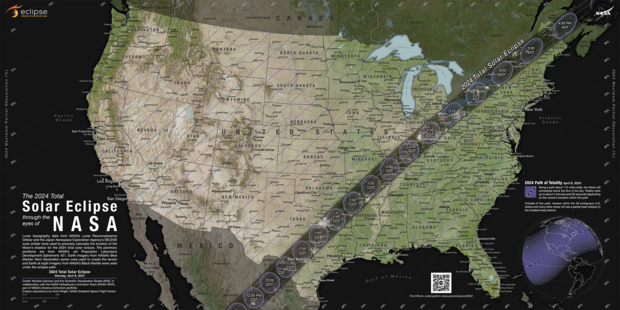
The eclipse attracted millions of spectators. Some areas where the event was most visible declared local states of emergency to account for the number of expected visitors.
When will the next total solar eclipse be visible in the U.S.?
After the April 8 eclipse, the U.S. won't see another total solar eclipse for decades. The next total solar eclipse visible from the United States will occur in August 2044.
Total solar eclipses typically happen every one to three years somewhere around the globe, but the events are often only visible from Earth's poles or from the middle of the ocean.

Kerry Breen is a reporter and news editor at CBSNews.com. A graduate of New York University's Arthur L. Carter School of Journalism, she previously worked at NBC News' TODAY Digital. She covers current events, breaking news and issues including substance use.
More from CBS News
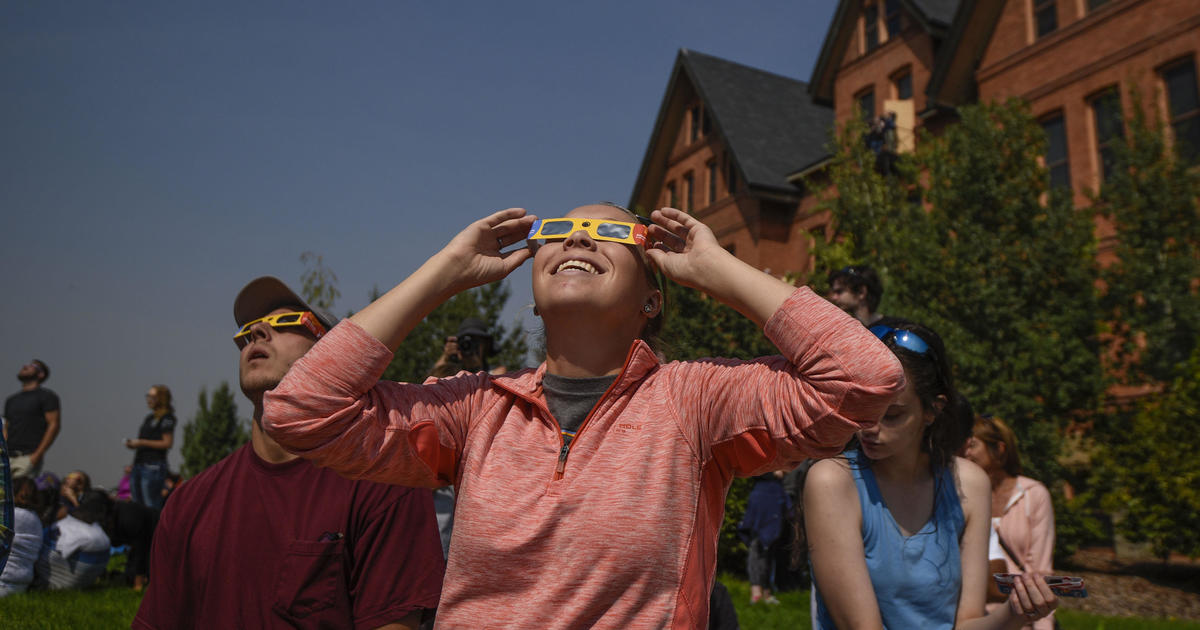
How often do total solar eclipses happen?
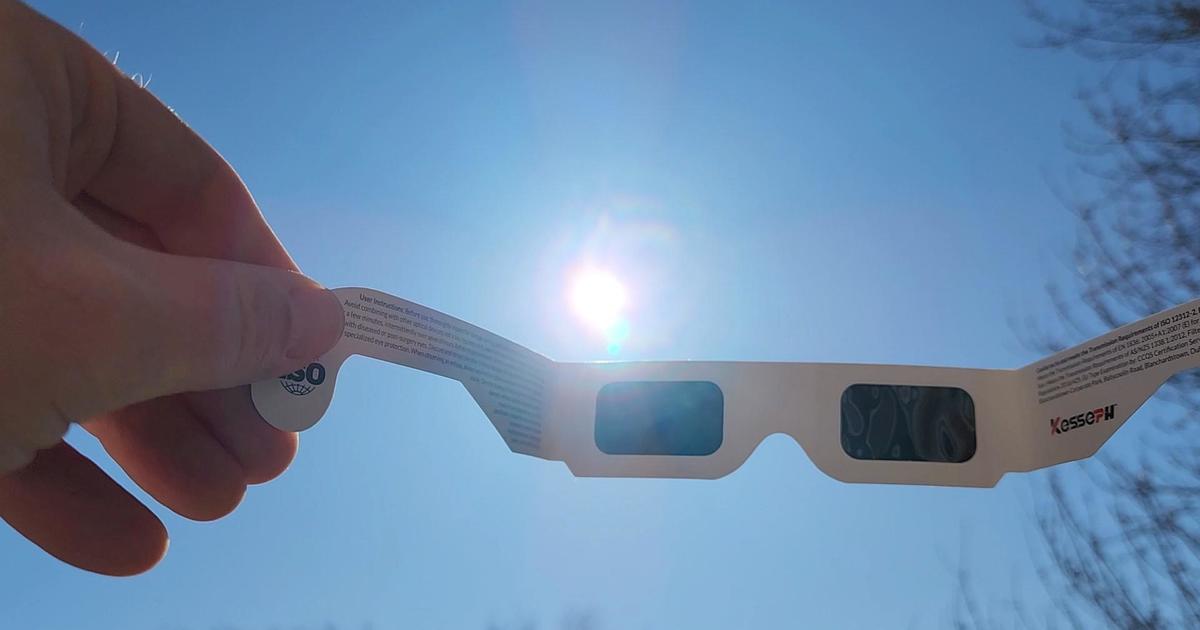
When is the next total solar eclipse in the U.S.?
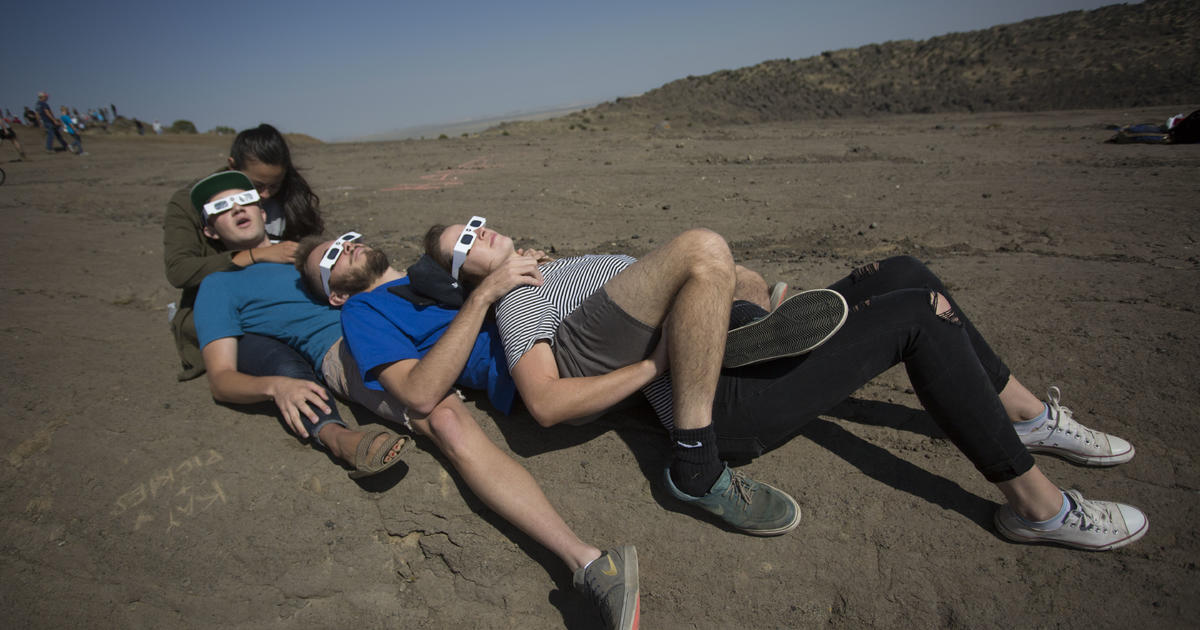
When was the last total solar eclipse in the U.S.? Revisiting 2017

Why do total solar eclipses happen? Learn what causes the celestial show
Advertisement
Giants' darren waller may not decide future before 2024 nfl draft, share this article.
If this were an installment of the “Ocean’s Eleven” franchise, the George Clooney character would be asking New York Giants tight end Darren Waller his signature question: Are you in, or are you out?
With the team beginning voluntary workouts next week, Waller, 31, is still undecided about whether he’ll continue his NFL career.
Last week in Las Vegas, however, Waller was seen working out and giving pointers to prospective draft picks at Las Vegas Sports Park with Raiders quarterback Aidan O’Connell.
Longtime Raiders beat reporter Vic Tafur, now of The Athletic, caught up with the former Raiders Pro Bowler, who has missed 19 games because of injuries the past three seasons. He asked if Waller would be returning to his current team, the Giants, or calling it a career.
“I have to make a decision at some point,” Waller said. “You have to be 100 percent bought in, for the grind. And I have to make sure I am bringing that to the table, or it’s a disservice to the guys I am suiting up with. I also want to give the team time, where whichever way I go, they can prepare for next season. So … it’s a little bit of a difficult decision, but here we are.”
The Giants are hoping to get an answer soon out of Waller. Before the NFL draft at the end of the month would be nice so the Giants can plan accordingly.
“That would be ideal, but I also don’t want to put that on myself,” he said. “It’s gotta be before summer break, for sure.”
The Giants have already backfilled their tight end room, adding Jack Stoll and Chris Manhertz in free agency to go along with the returning Daniel Bellinger.
Waller stands to lose $200,000 by missing the Giants’ offseason program and $11.8 million if he decides to retire.
Ex-Giants safety Logan Ryan announces retirement from football
Dante miller recalls his unlikely path to the giants, giants trade down, land dynamic player in latest the athletic mock draft.
Follow the Giants Wire Podcast: Apple Podcasts | Spotify | Google Podcasts
Want the latest news and insights on your favorite team?
Sign up for our newsletter to get updates to your inbox, and also receive offers from us, our affiliates and partners. By signing up you agree to our Privacy Policy
An error has occured
Please re-enter your email address.
Thanks for signing up!
You'll now receive the top Giants Wire stories each day directly in your inbox.
Most Popular
Giants' joe schoen on poor offensive line: 'you can't run a play', giants' joe schoen: people assume we're going qb but we have other needs, giants land spencer rattler in chad reuter's 5-round mock draft, giants met with british columbia ol giovanni manu, 2024 nfl draft: giants hosted multiple prospects at local pro day.
Please enter an email address.
Thanks for signing up.
Please check your email for a confirmation.
Something went wrong.
- FanNation FanNation FanNation
- SI.COM SI.COM SI.COM
- SI Swimsuit SI Swimsuit SI Swimsuit
- SI Sportsbook SI Sportsbook SI Sportsbook
- Tickets SI Tickets SI Tickets
- SI Showcase SI Showcase SI Showcase
- SI Resorts SI Resorts SI Resorts

© James Guillory-USA TODAY Sports
Browns Host Another Quarterback On Top-30 Visit
Former Tulane quarterback Michael Pratt visited the Cleveland Browns on Friday. He is the second quarterback prospect to spend time in Berea prior to the 2024 NFL Draft.
- Author: Cole McDaniel
In this story:
The Cleveland Browns reportedly brought in former Tulane quarterback Michael Pratt on a pre-draft top-30 visit on Friday. The team recently hosted Joe Milton of Tennessee, making Pratt the second QB to spend time in Berea prior to the upcoming NFL Draft.
Tulane QB Michael Pratt visited yesterday with the Cleveland Browns, source said. — Ryan Fowler (@_RyanFowler_) April 6, 2024
In 2022, Pratt threw for 3,010 yards, 27 touchdowns and only had five interceptions for Tulane. Pratt's total numbers took a slight drop in 2023 with 2,406 passing yards, 22 touchdowns and matched the same mark of five interceptions. In his final season with the Green Wave, Pratt did throw the ball 55 less times than the year prior and his completion percentage increased by two percent.
Pratt is my 122nd overall prospect in this year's class and slots in as my eighth ranked quarterback.
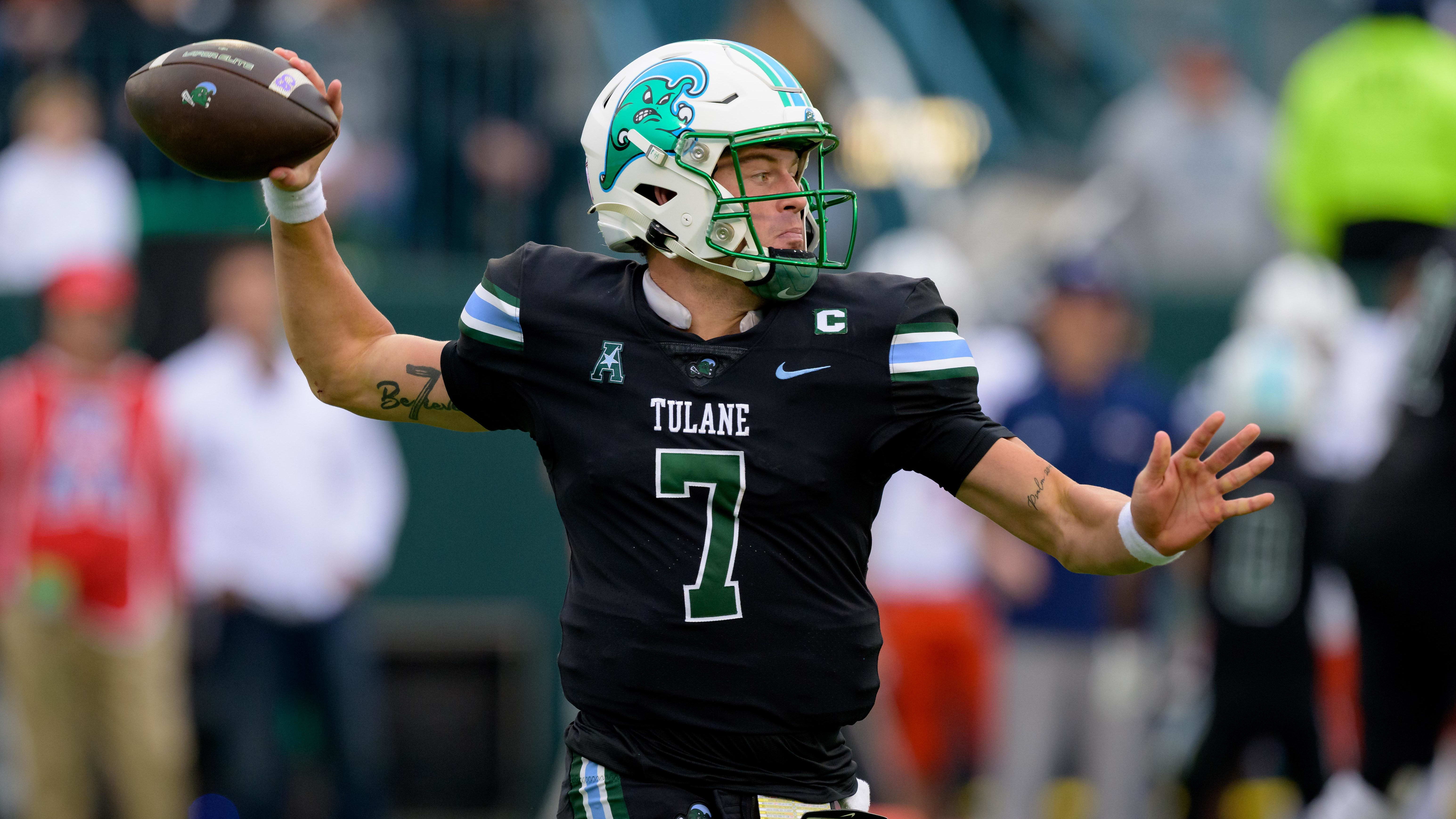
Nov 24, 2023; New Orleans, Louisiana, USA; Tulane Green Wave quarterback Michael Pratt (7).
Matthew Hinton-USA TODAY Sports
Thoughout his time in college, Pratt displayed good poise in the pocket and is not afraid to deliver throws even when knowing he will take a hit. Despite not being a true running quarterback, he is also athletic enough to scramble when necessary. Similar to Will Levis of last year's draft class, Pratt struggles with reading the defense consistently and doesn't throw players open. Both of these weaknesses will need to improve before taking valuable reps in the NFL.
If the Browns do decide to select a quarterback, then Pratt is a safer selection than Joe Milton. Milton has turned heads due to his size and freakish arm strength. Milton has a long way to go with his footwork and lacks reliable accuracy though. Pratt does not have the mechanical issues, which should count for a lot when comparing the two prospects.
Deshaun Watson is returning from his shoulder surgery which ended his season early in 2023. He recently began throwing and is expected to be ready to go for Week One in 2024. Behind Watson on the depth chart, Cleveland added Jameis Winston and Tyler Huntley this offseason. Dorian Thompson-Robinson is also entering his second season with the organization.
Some people strongly believe in drafting a quarterback every single year. However, it is extremely difficult to imagine that the front office would select a quarterback and carry five by the time of the regular season.
Unless Cleveland decides to move Huntley or Thompson-Robinson prior to September, then Pratt will likely not be wearing the orange and brown to begin his NFL career.
Latest Browns News
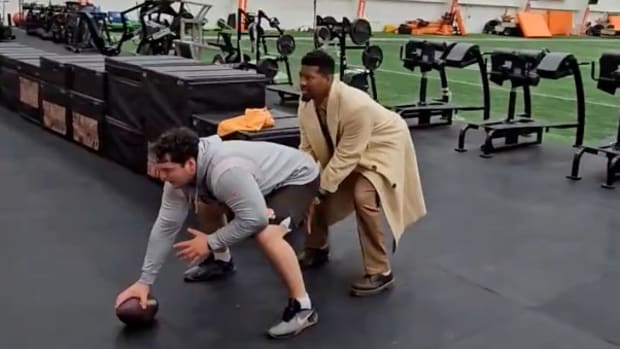
Jameis Winston Took Snaps Under Center in Full Suit After Signing With Browns

Browns New QB Jameis Winston Says He's Still Eating Ws
Jameis winston's message for deshaun watson on seeking redemption.

Browns Expected To Add RB D'Onta Foreman

Jameis Winston: His Farewell Video And Expressions Of Gratitude, Fond Memories, And Love For New Orleans, Saints, And Who Dat Nation

IMAGES
COMMENTS
3. The Guardian - Music. Prior to the visit they had to complete a headache diary for at least 1 month. 4. The Journal of Headache and Pain. We'd be happy to personally brief Mr Cameron or his officials prior to the visit. 5. BBC. She first felt a mass of the size of her thumbnail 5 years prior to the visit.
That's why we believe "before" is always a better choice than "prior to.". We know what some of you are thinking: "'prior to' is a better fit for a project proposal or report because it sounds more formal.". After all, you're probably used to seeing corporate and legal documents that are peppered with this term.
Prior as an Adjective: In its adjective form, prior is used to describe something that comes before or takes precedence over something else. It can modify a noun directly or be part of a prepositional phrase. Example 1: The team conducted a thorough analysis of the prior data before making any conclusions.
prior to visiting. from inspiring English sources. "prior to visiting" is a correct and usable phrase in written English. It can be used to refer to something happening before or earlier than a specified event, such as a visit. For example, "We discussed the arrangements prior to visiting the client's office.".
The meaning of PRIOR TO is in advance of : before. How to use prior to in a sentence. Usage of Prior To: Usage Guide
PRIOR TO SOMETHING meaning: 1. before a particular time or event: 2. before a particular time or event: . Learn more.
A laptop, phone, or tablet would be necessary for conduction of the telemedicine visit itself. Patients should ensure these devices work properly prior to the visit as well. This can be accomplished by video-chatting a family member or friend to ensure the microphone and camera are functioning properly.
PREPARATION: PRIOR TO THE APPOINTMENT. A pre-visit questionnaire for the patient can elucidate what issues the patient wants to address during the appointment. The limited-time of a healthcare appointment can be best spent if the provider knows which questions to ask and which clinical exams need to be completed. A visit will not be well-spent ...
AI Feedback. "prior to your visit" is correct and usable in written English. You can use this phrase to refer to something that happened before a specific time. For example, "We had to make several preparations prior to your visit.". exact ( 10 ) However, you may wish to consider the following suggestions prior to your visit: View some examples ...
1. Some Latin adjectives like prior, junior, superior, posterior, anterior etc always have preposition 'to' after them in. English. We know infinitive is a verb form with 'to' as its integral part (except bare infinitive and the few special uses). After comparatives as these with preposition'to' as their integrals, we use a gerund because of ...
So yes, the site visit means you're fully in the "hirable" zone. But the site interview is still a test—albeit a different kind of one. Dolansky says, "Studies show that 25 to 30% of the hiring decision is based on background.". This includes factors like education and training.
Pre-visit planning takes place in several steps: 1. Plan forward, or "The next appointment starts today." 5 The most efficient form of pre-visit planning begins near the end of the previous ...
The process begins at the end of the current visit: • Identify what labs or other tests the patient should complete before the next visit. Using a " post-appointment order sheet " can be ...
The visit planner is a checklist that allows the physician to indicate the interval until the next appointment and any associated labs required prior to that visit. It should be quick and convenient to use, requiring no more than a few seconds of physician time. The visit planner checklist can be used by a medical assistant (MA) or other team
You also should ensure attendees know the purpose of the meeting, along with any reports, pre-reading, or requests for materials a day or two in advance. To create a solid pre-meeting email template, we suggest you follow these steps: 1. Include a specific subject line. For simplicity, the subject line should include the meeting day and topic.
Pre-visit planning includes scheduling patients for future appointments at the conclusion of each visit, arranging for pre-visit lab testing, gathering the necessary information for upcoming visits and spending a few minutes to huddle and hand off patients. Pre-visit planning can increase efficiency often saving 30 minutes of both physician and ...
before the visit. before visiting. familiarization visit. acquaintance tour. ahead of the visit. ahead of visiting. exploratory visit. fact-finding mission. familiarity tour.
The visit on March 27 is not billable, as it is the preoperative H&P visit and is included in the surgical package." Source: AMA CPT® Assistant, May 2008/Volume 19, Issue 5, pp. 9, 11 CPT® says once the decision is made to proceed with surgery, the subsequent visits related to the procedure (e.g., an H&P, getting consent form signed ...
The collapse of the Francis Scott Key Bridge came just days before the start of crab season in the Chesapeake Bay, but the accident, which has cut off Baltimore's port, seems unlikely to disrupt ...
Before the onsite visit then, ask your questions and voice your concerns. Our auditors can't answer questions that never get answered or address concerns that are never shared. This level of transparency builds our relationship and will only help the success of your audit. 3. Review the Agenda.
Access Subject Schedule by Enrollment. Prior to each study visit, the research team must be prepared for all known and unknown tasks that may need to be completed per protocol. If applicable, physician orders need to be completed and authorized for lab draws, study medication and additional testing; research lab kits should be prepared and ...
During a visit to the Francis Scott Key Bridge collapse site on Friday, President Joe Biden pledged federal support for the recovery effort while offering his condolences to the families of six ...
The official visit kicks off in earnest on Wednesday with the full pomp and circumstance of a South Lawn arrival ceremony, bilateral meeting, joint news conference and lavish state dinner.
Physicians and other care team members can also spend more time on the visit and less time on paperwork while being confident they have a complete medical history. A new patient coordinator (NPC) conducts new patient pre-registration over the phone or in person prior to the initial visit. This conversation enables the new patient coordinator to ...
Welcome to The Hill's Business & Economy newsletter {beacon} Business & Economy Business & Economy The Big Story What to know before the tax deadline The April 15 tax filing deadline is fast ...
The day before my office hours, I start my progress note for each patient by selecting the appropriate return visit note template (I have different templates for different diseases: one for interstitial lung disease, one for asthma, one for COPD, etc.). I pre-populate any new test results and pre-populate my final "impression" by pasting in ...
The path of totality for this eclipse stretched from Texas to the Northeast. The eclipse started on Mexico's Pacific coast at just after 11 a.m. PDT before traveling across the U.S. and into ...
New York Giants TE Darren Waller won't commit to a retirement decision prior to the 2024 NFL draft: 'Don't want to put that on myself.'
Prior to tonight's game, the Yankees made the following roster moves: • Signed LHP Josh Maciejewski (#61) to a Major League contract and selected him to the active roster.
Former Tulane quarterback Michael Pratt visited the Cleveland Browns on Friday. He is the second quarterback prospect to spend time in Berea prior to the 2024 NFL Draft.